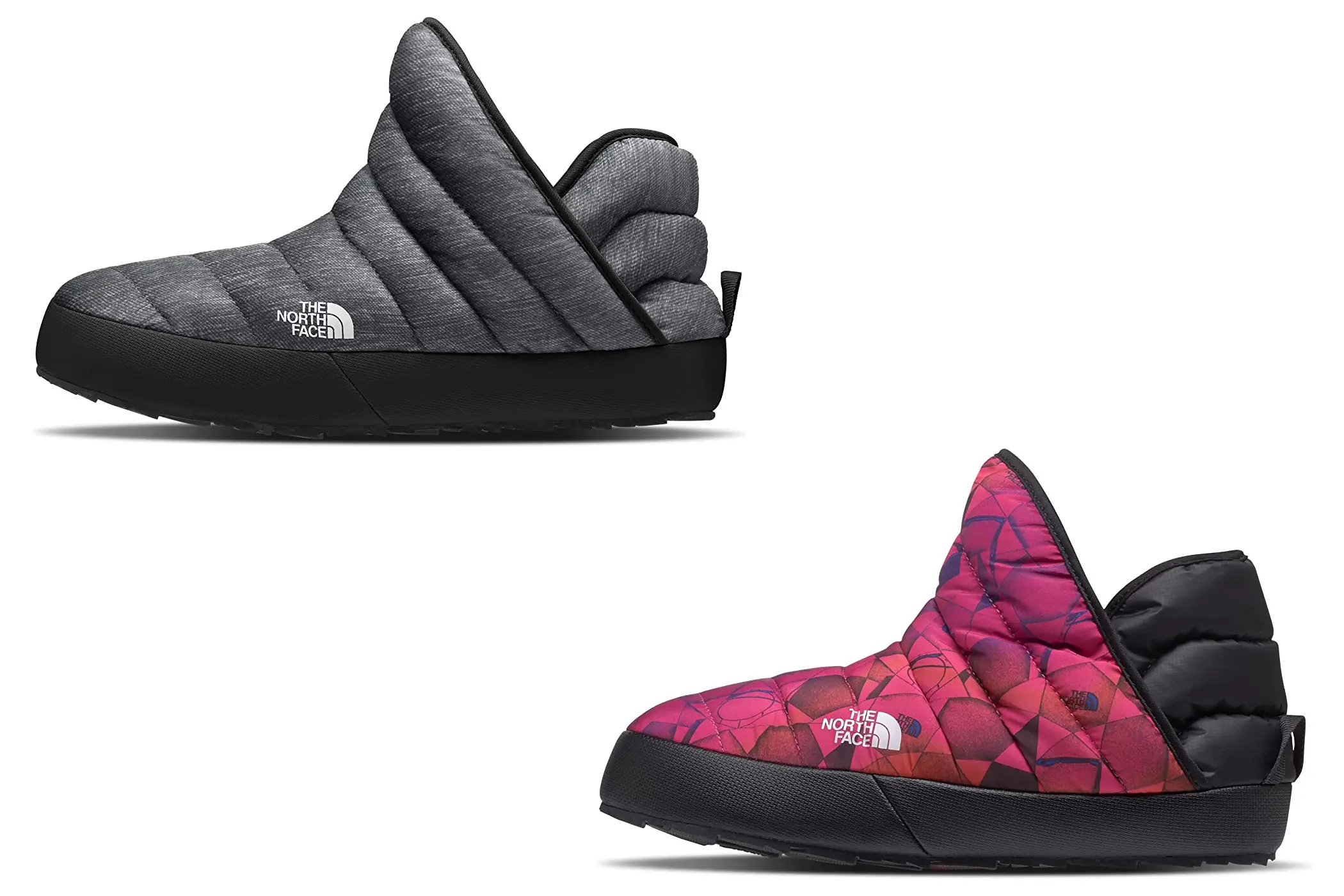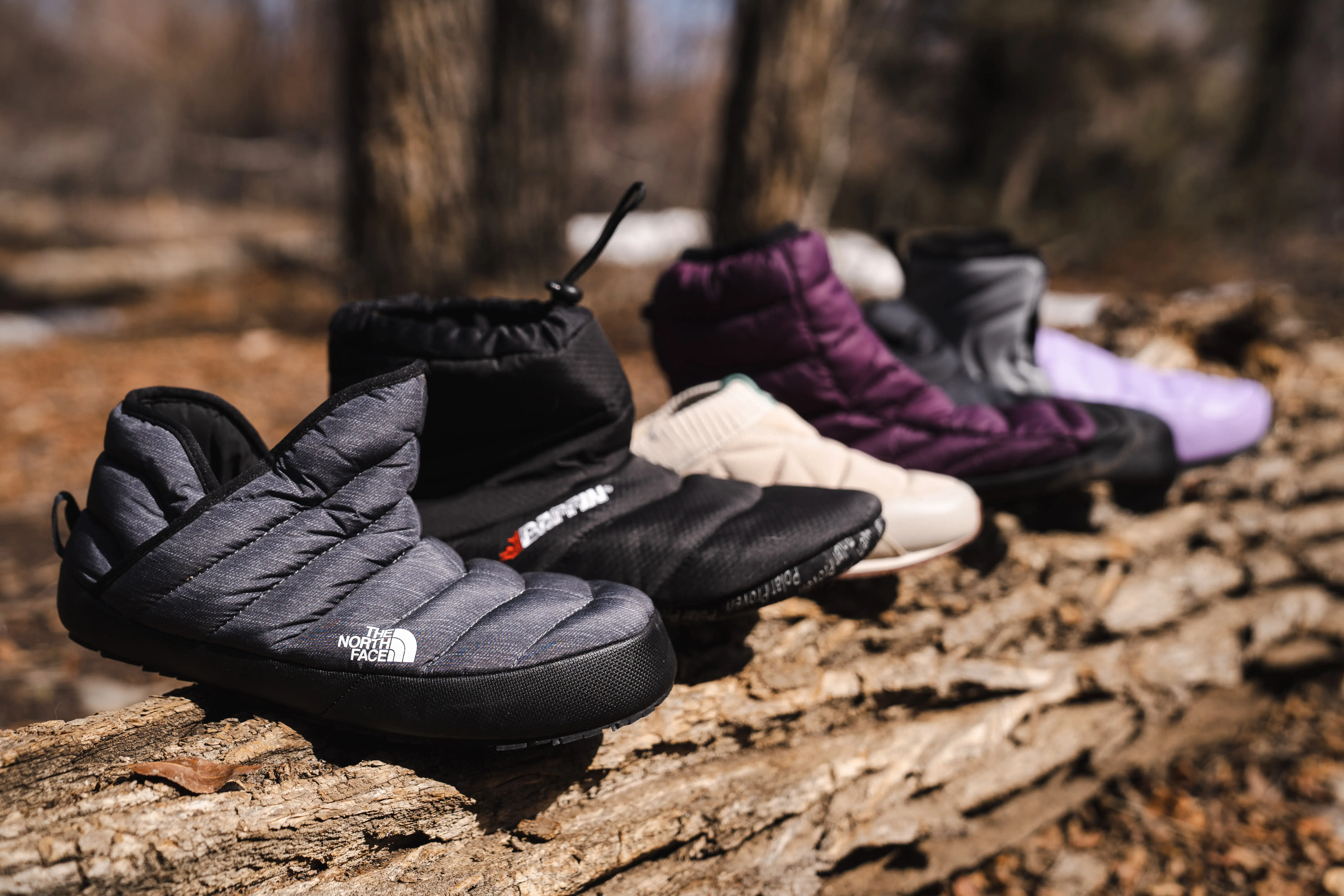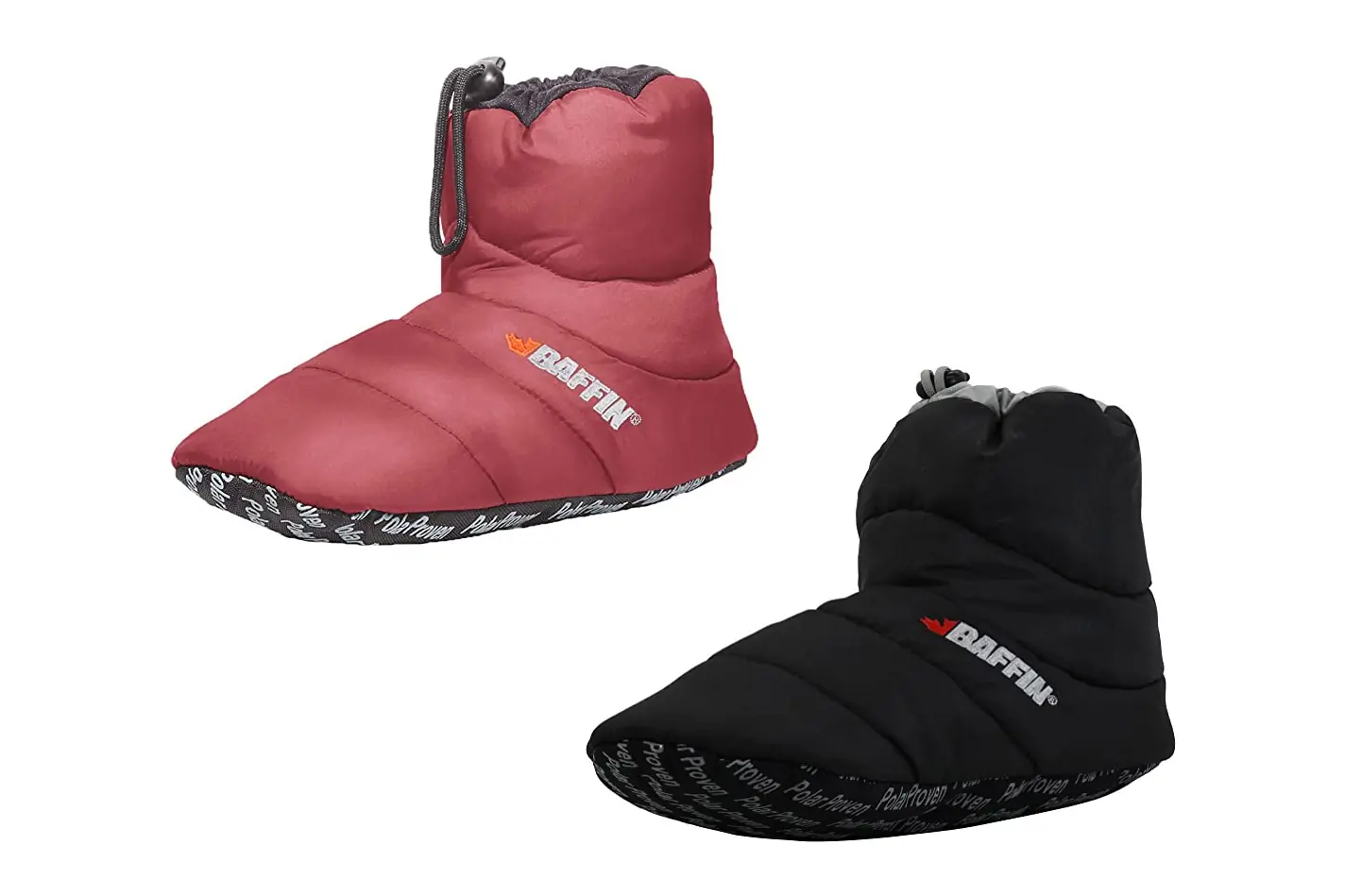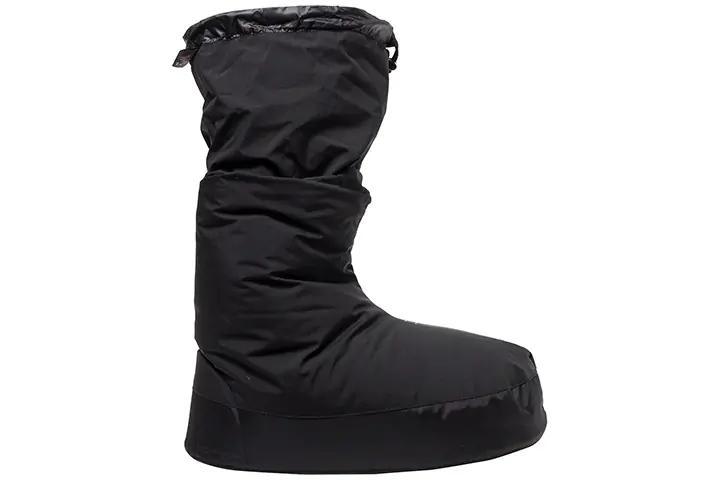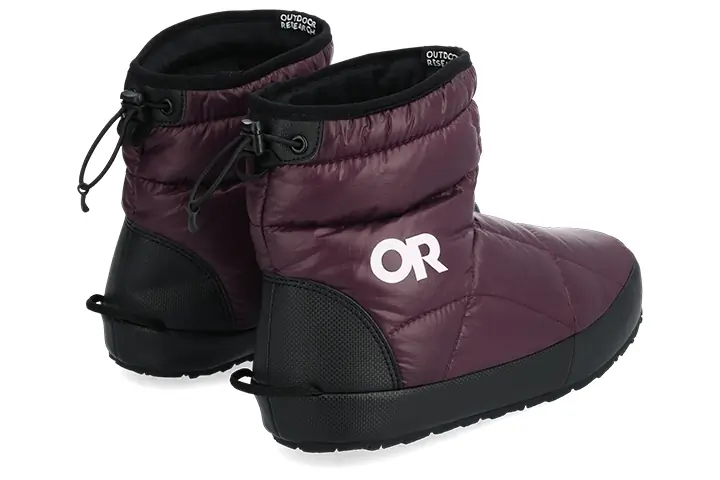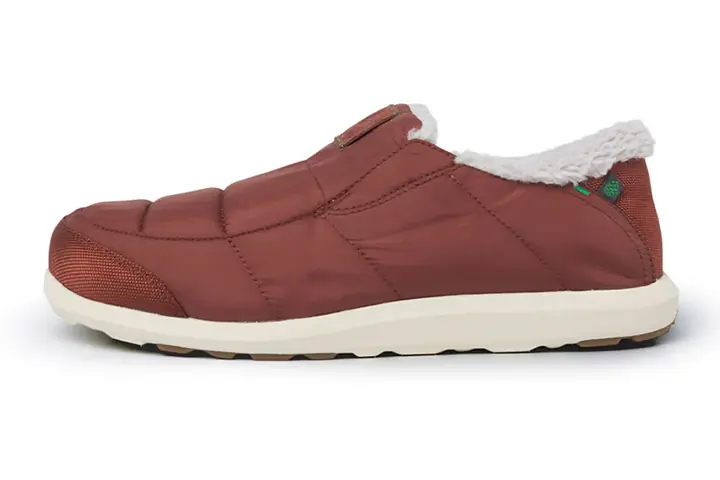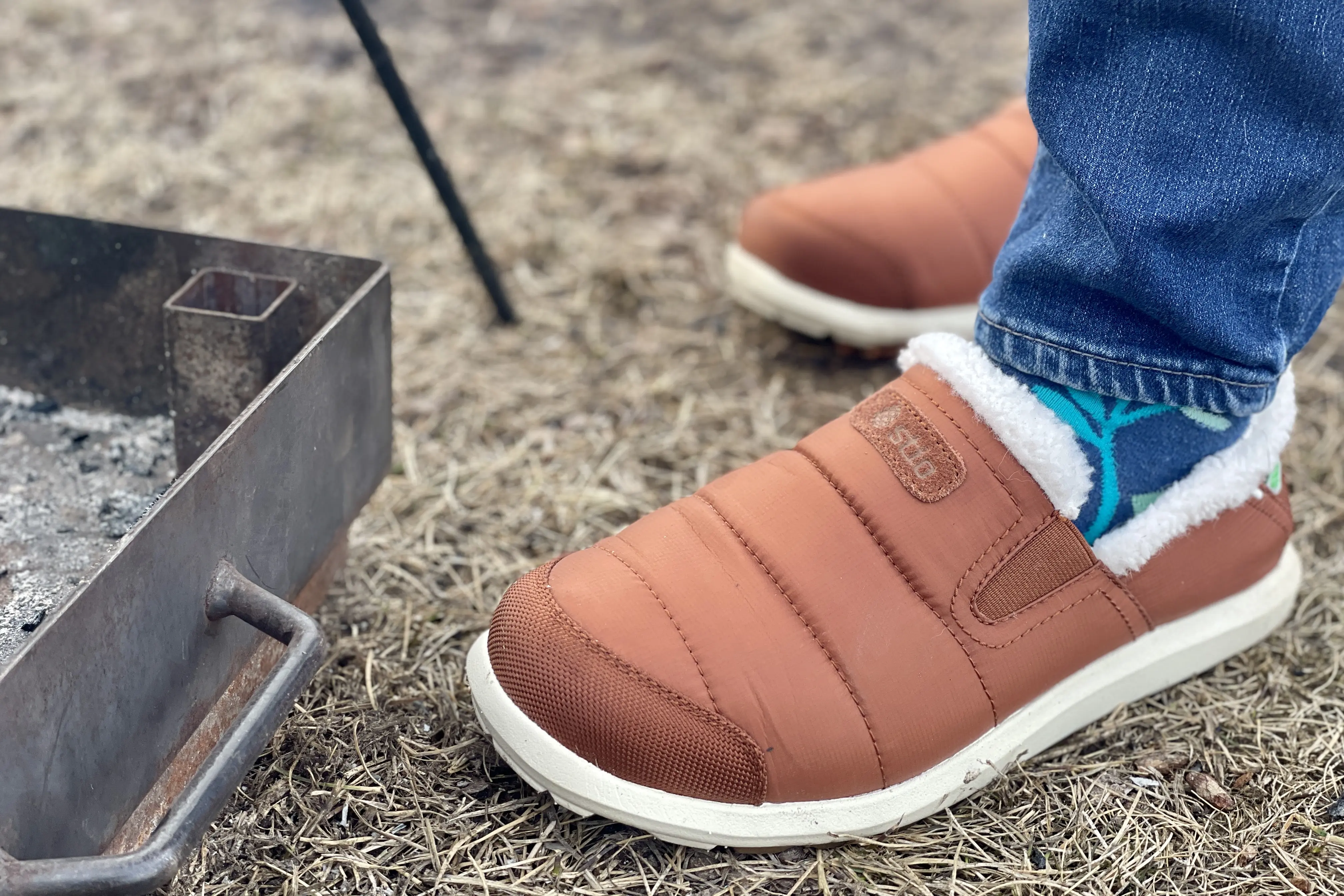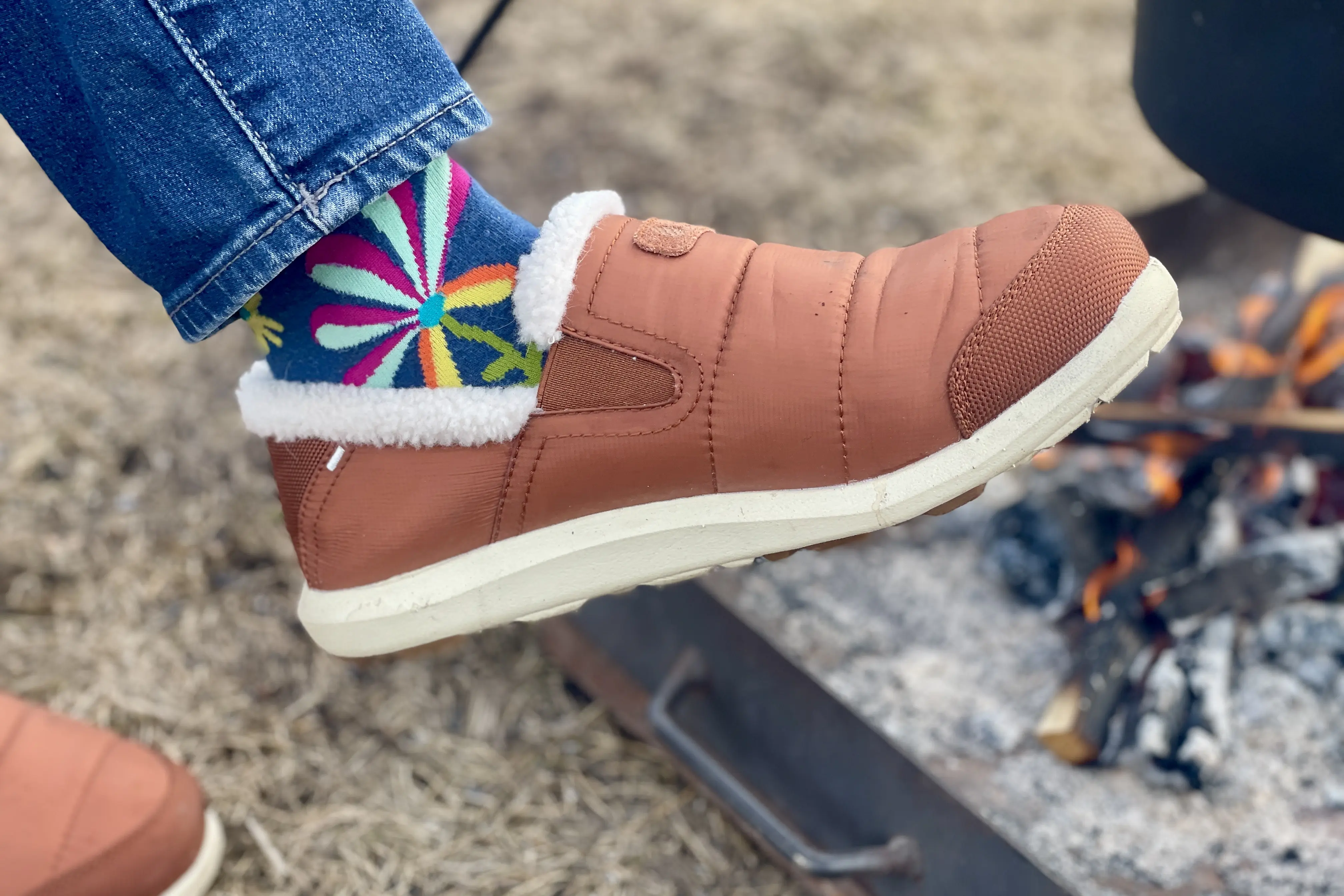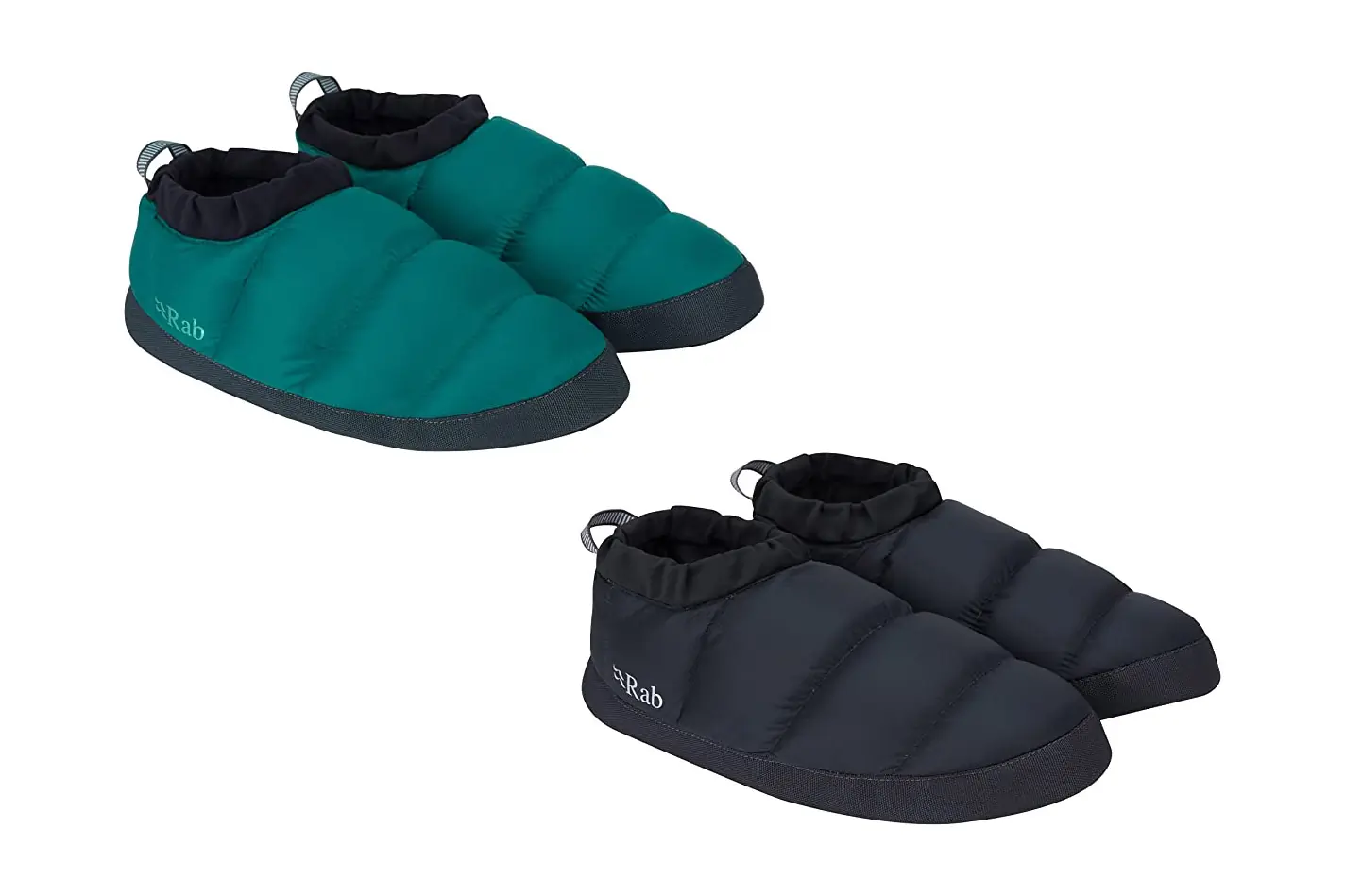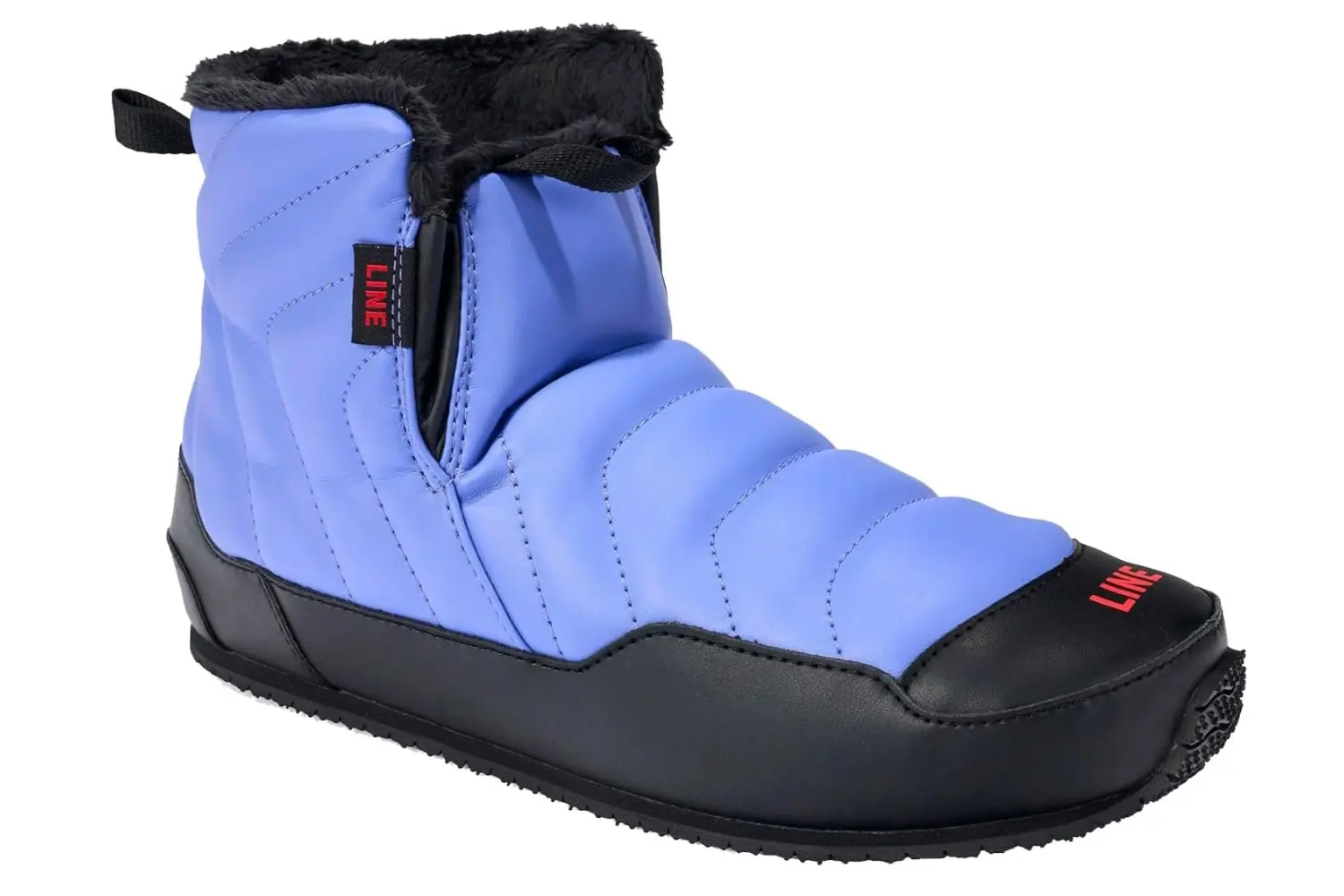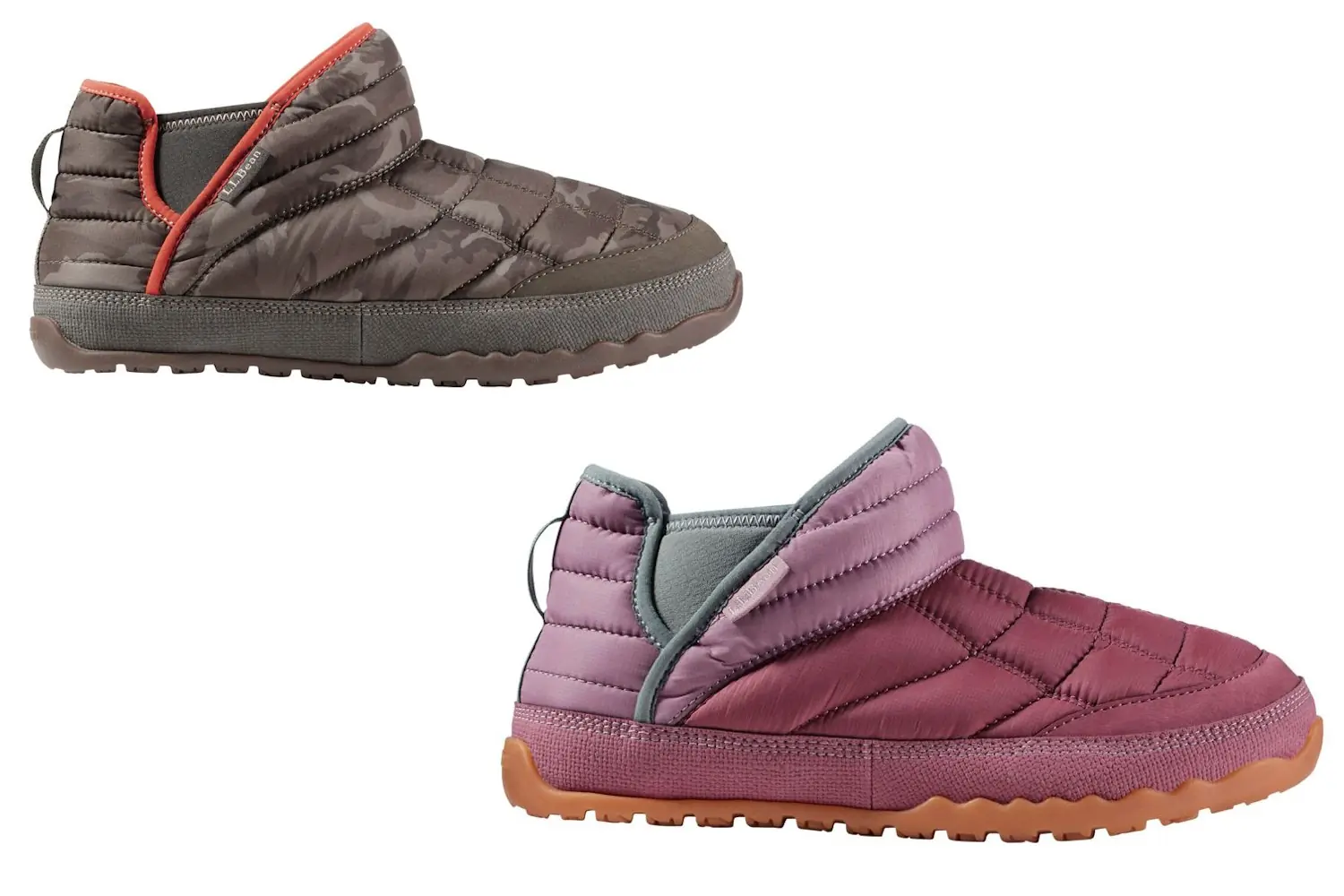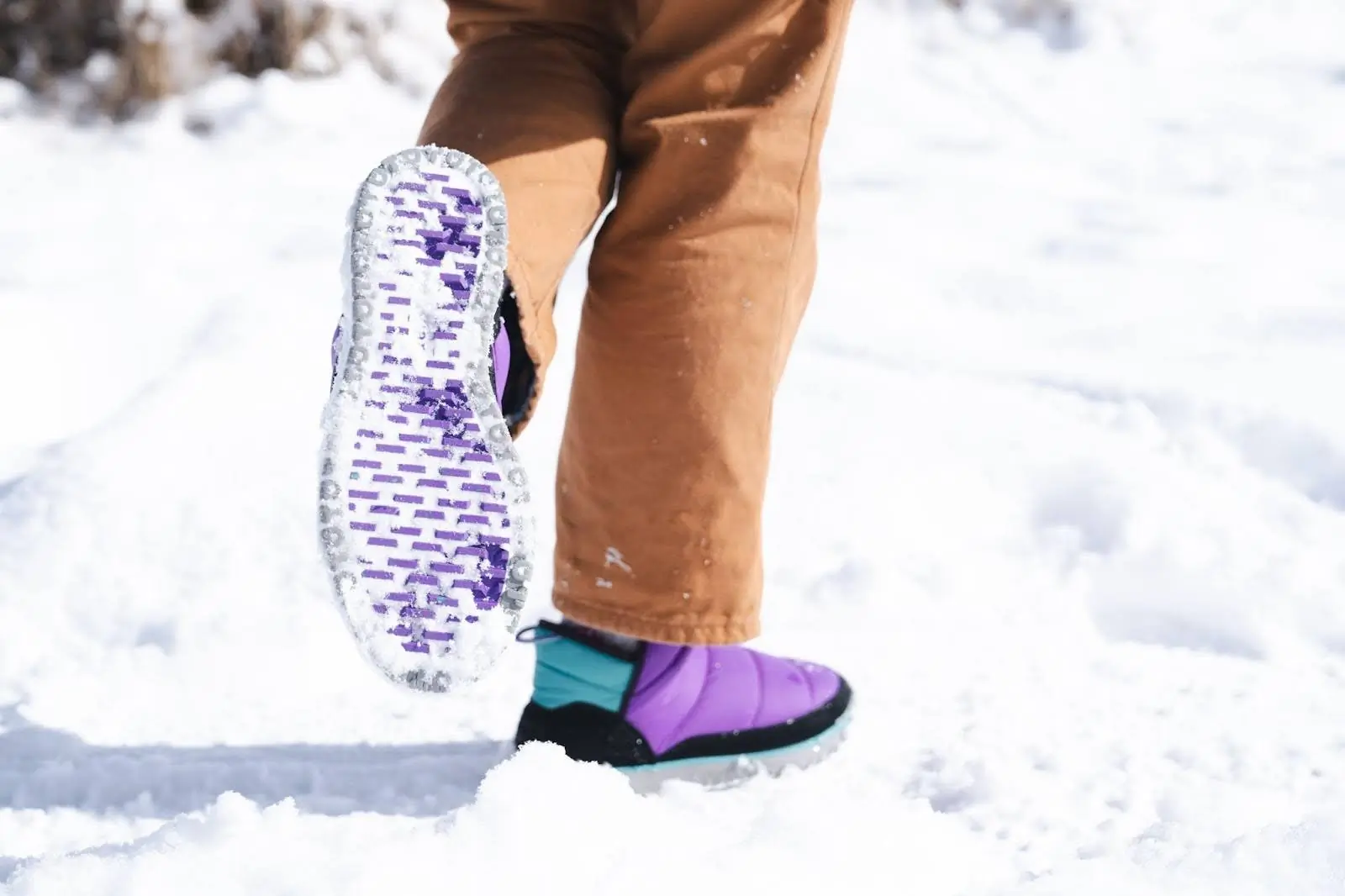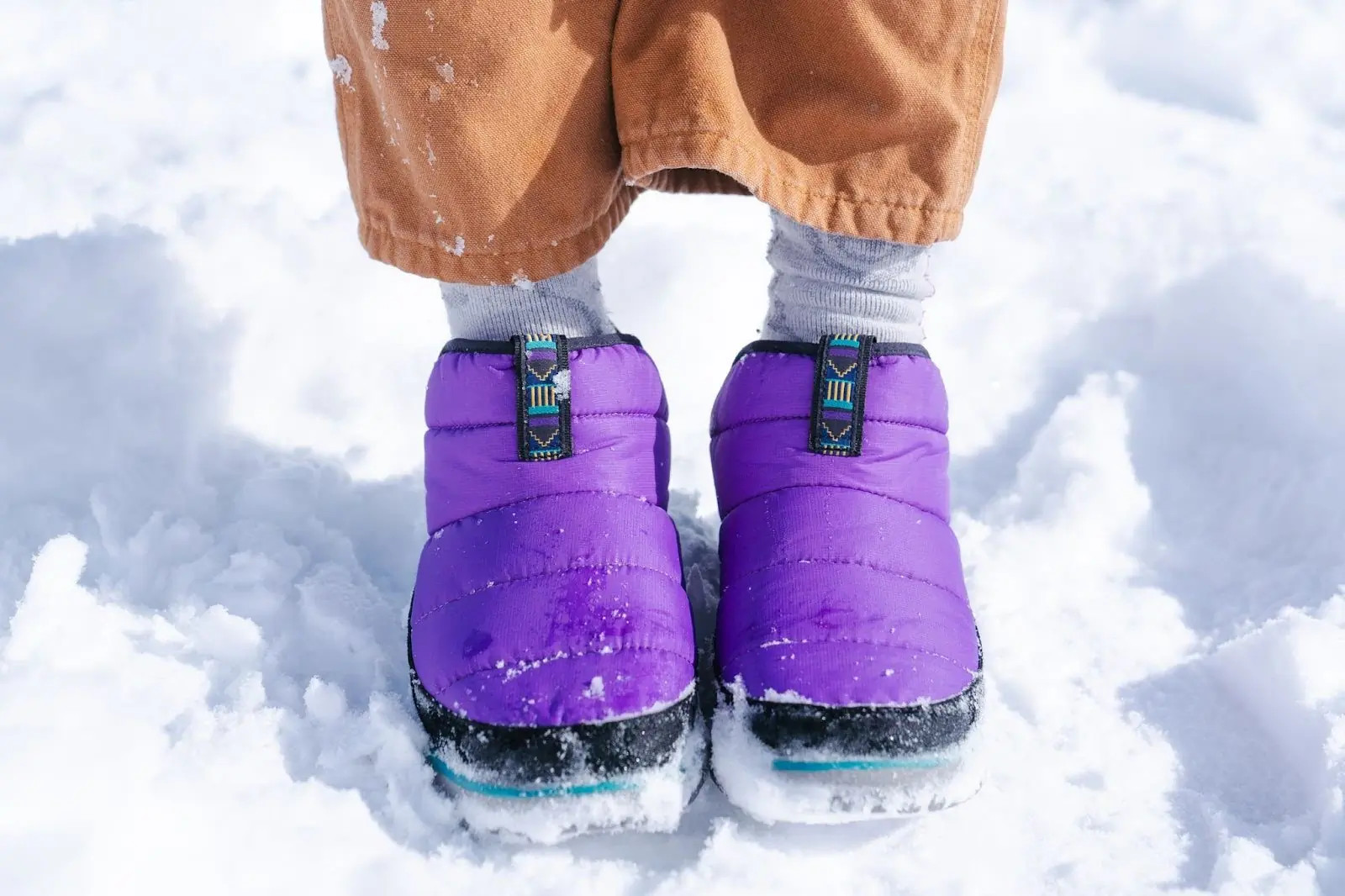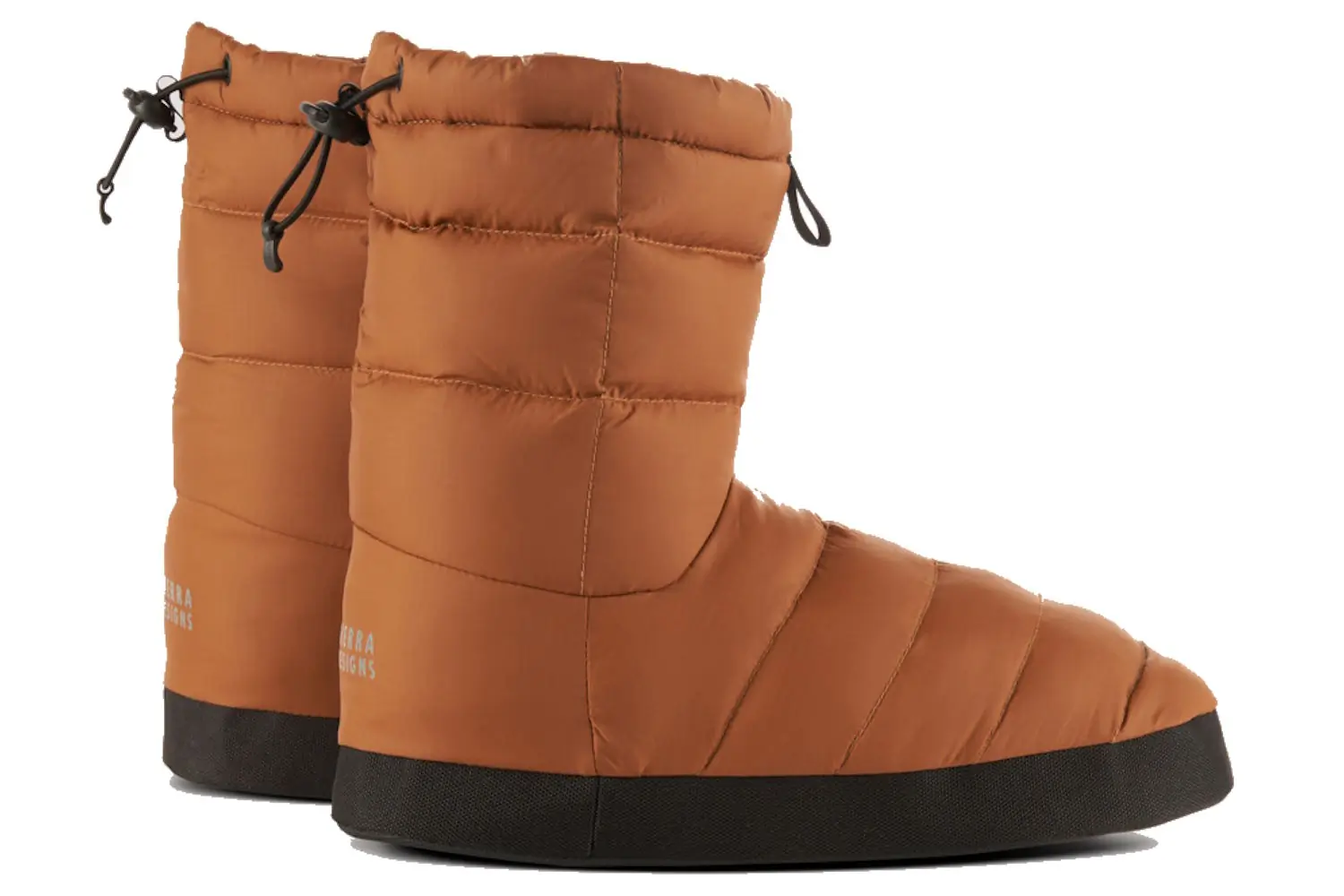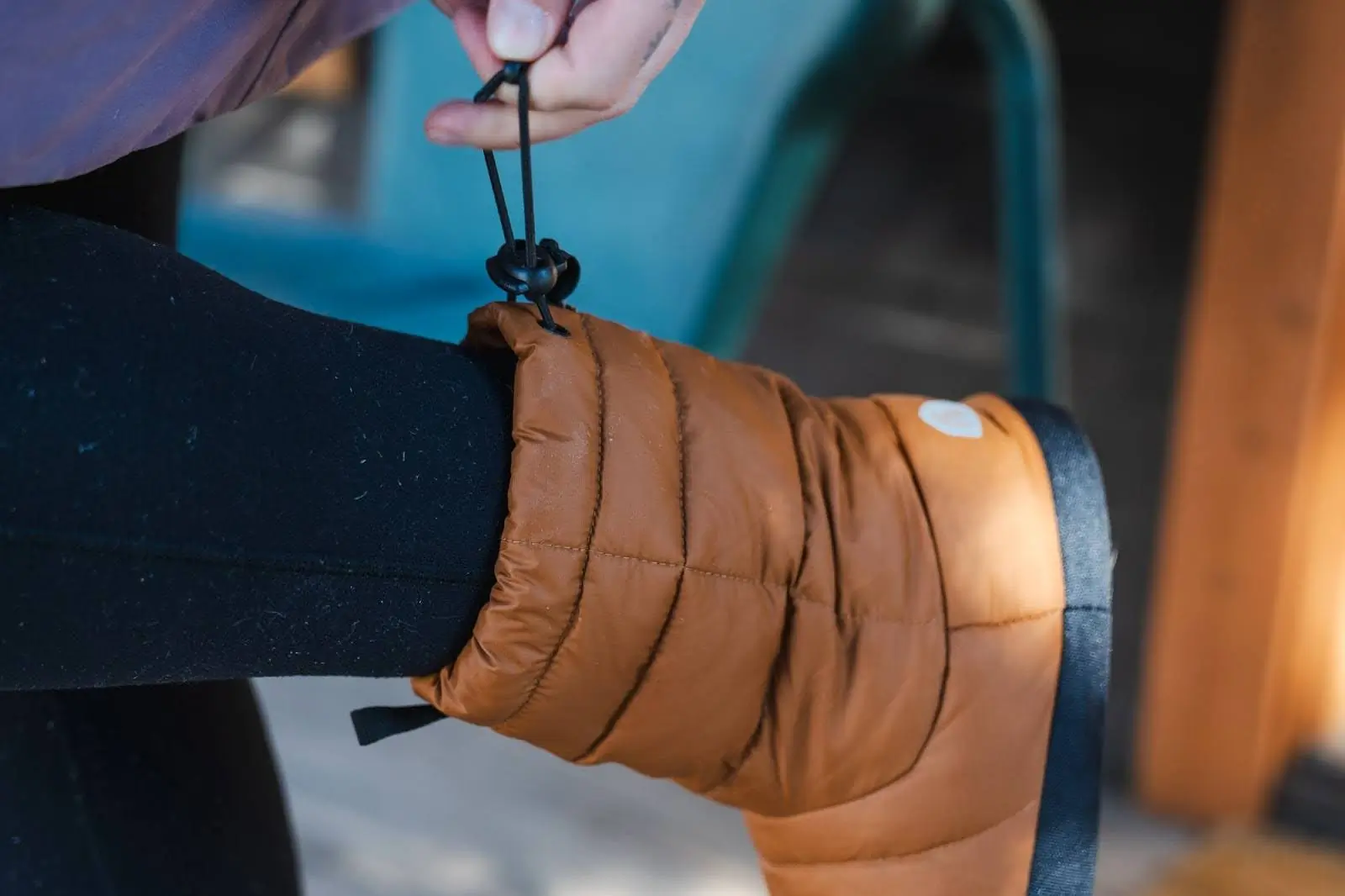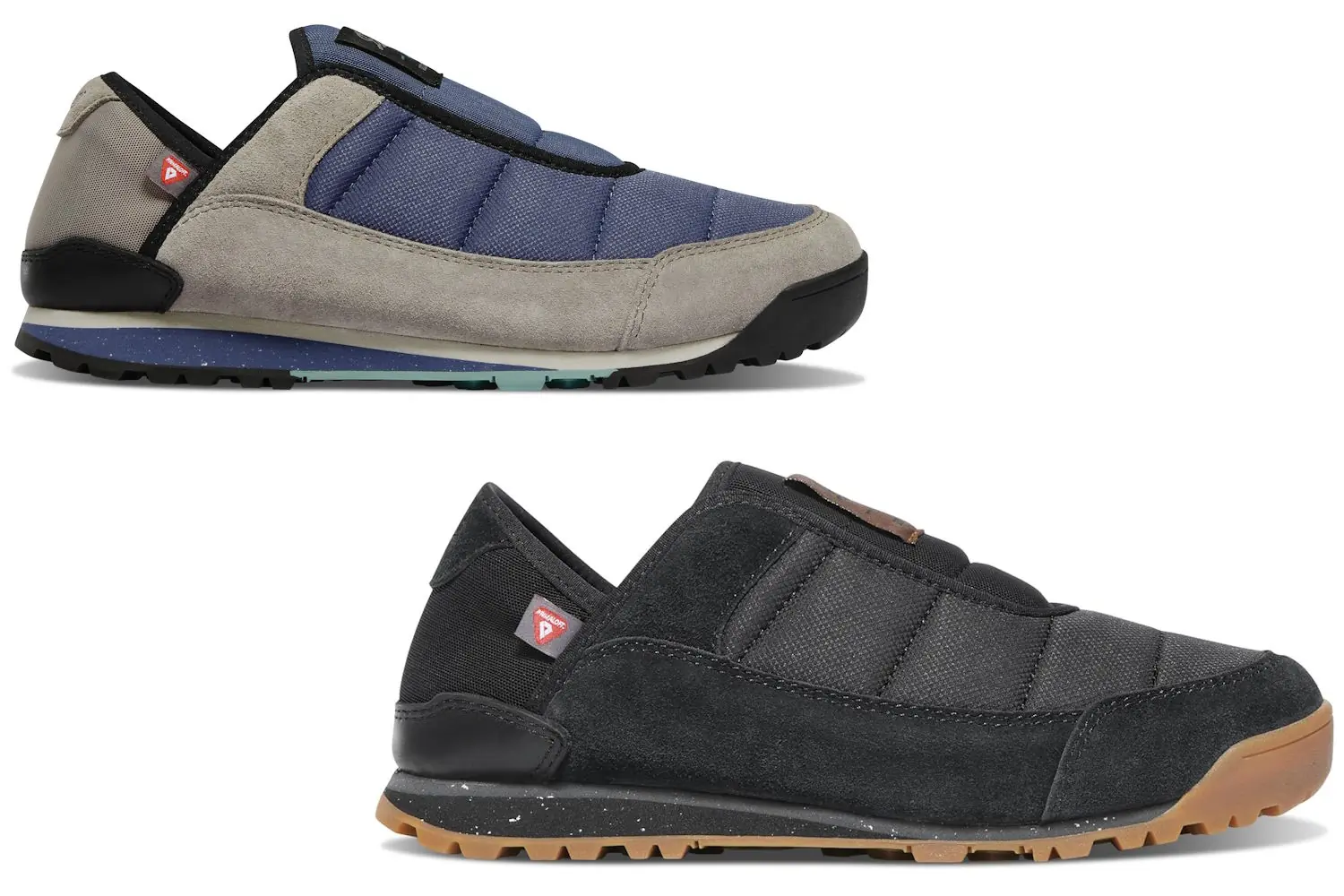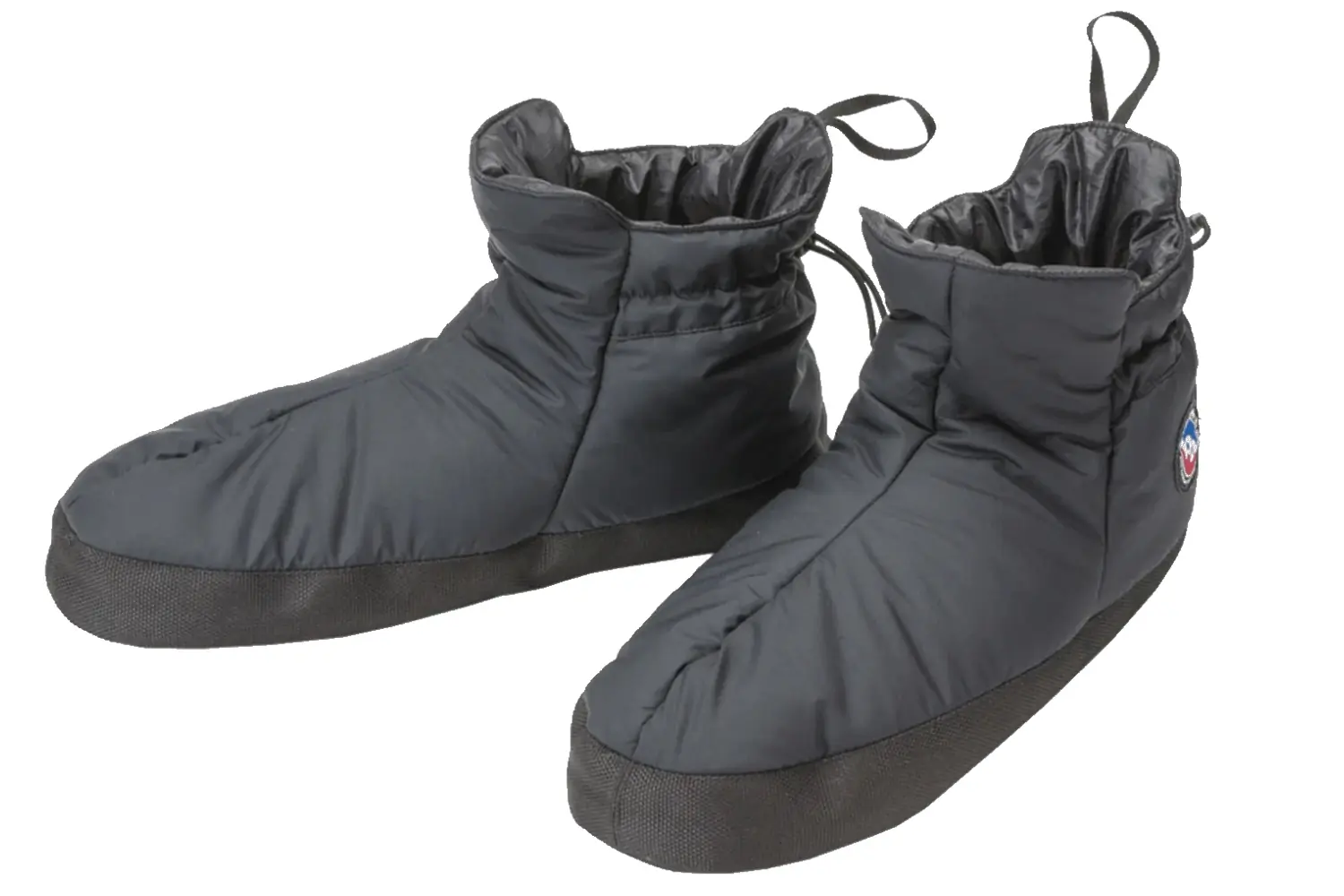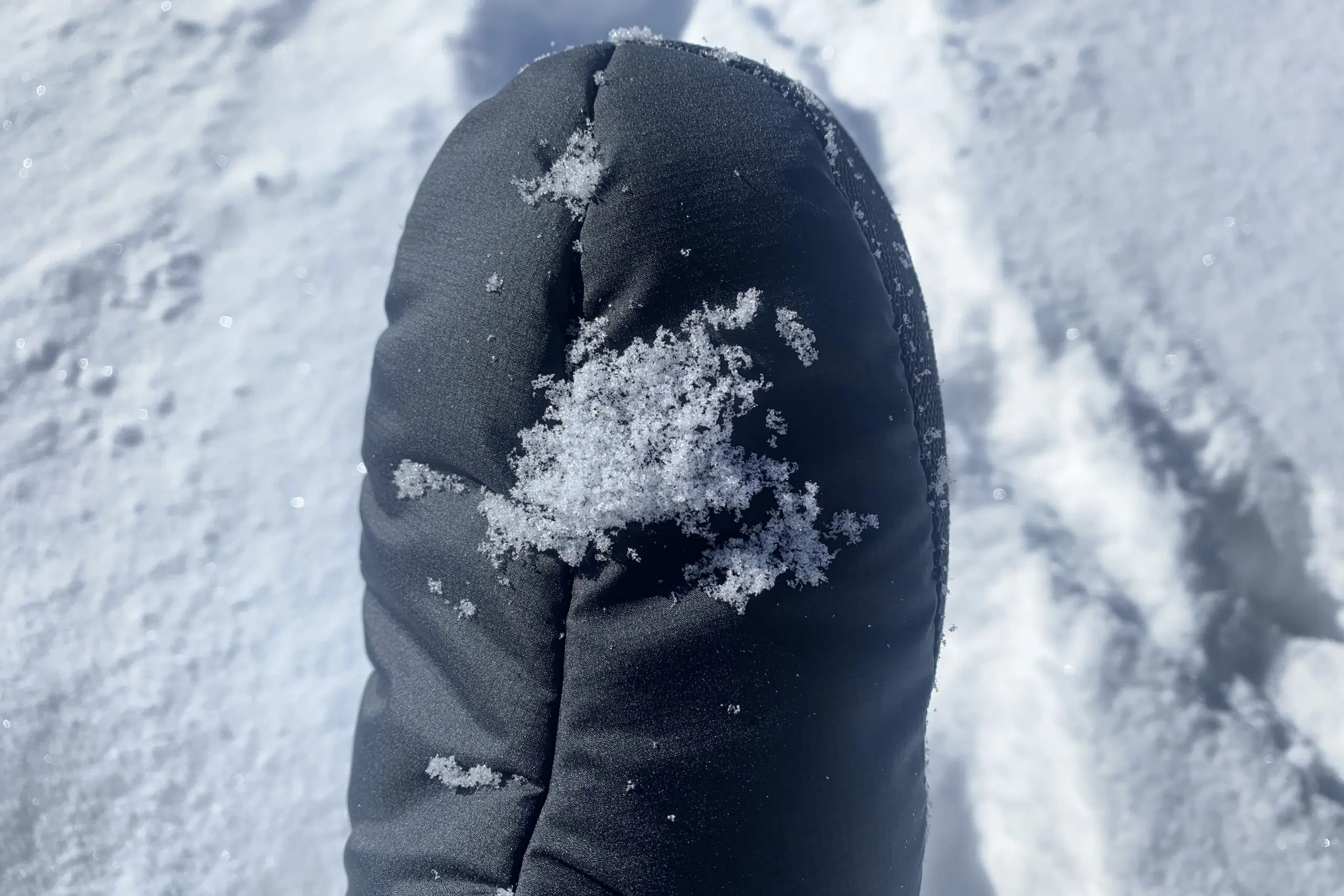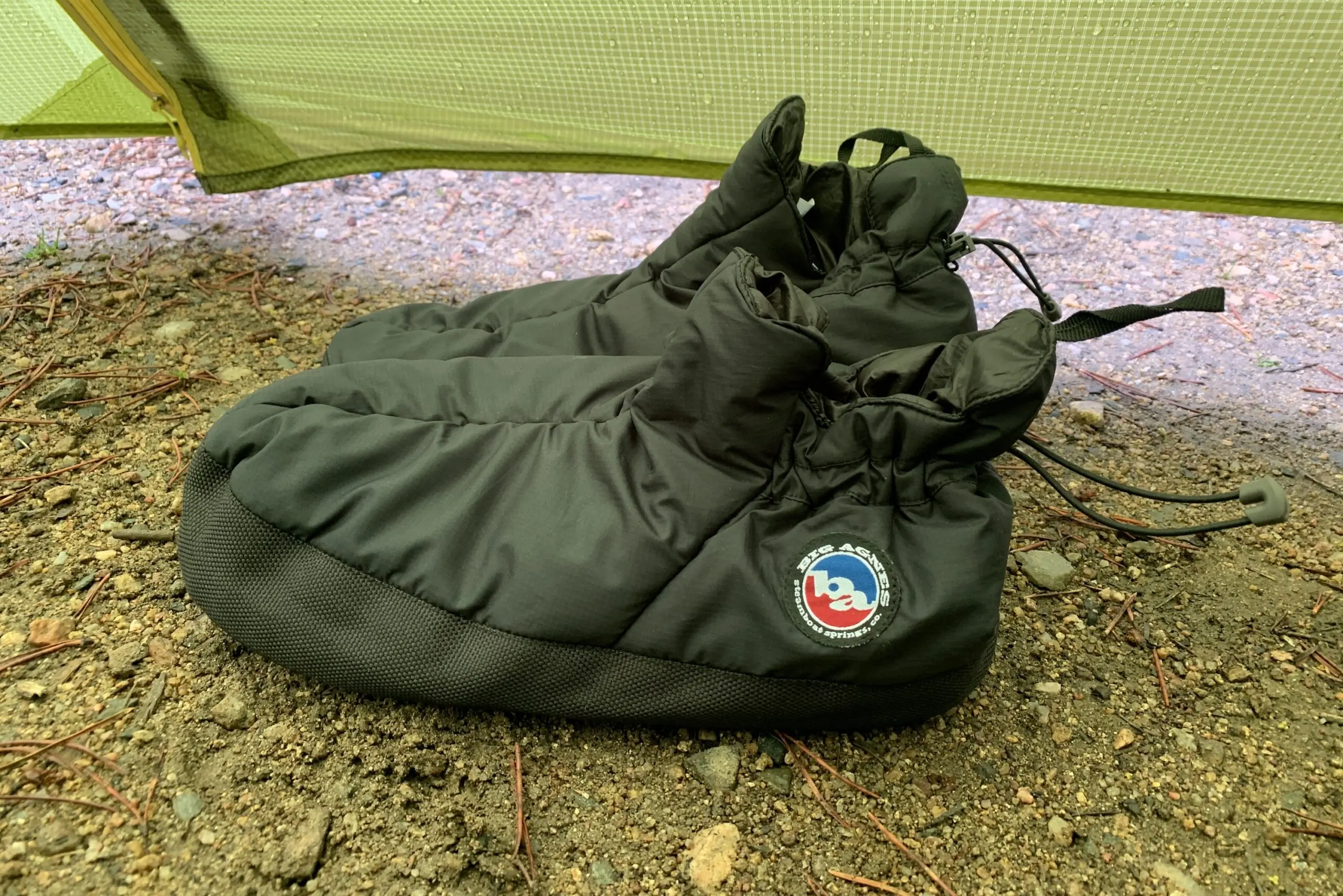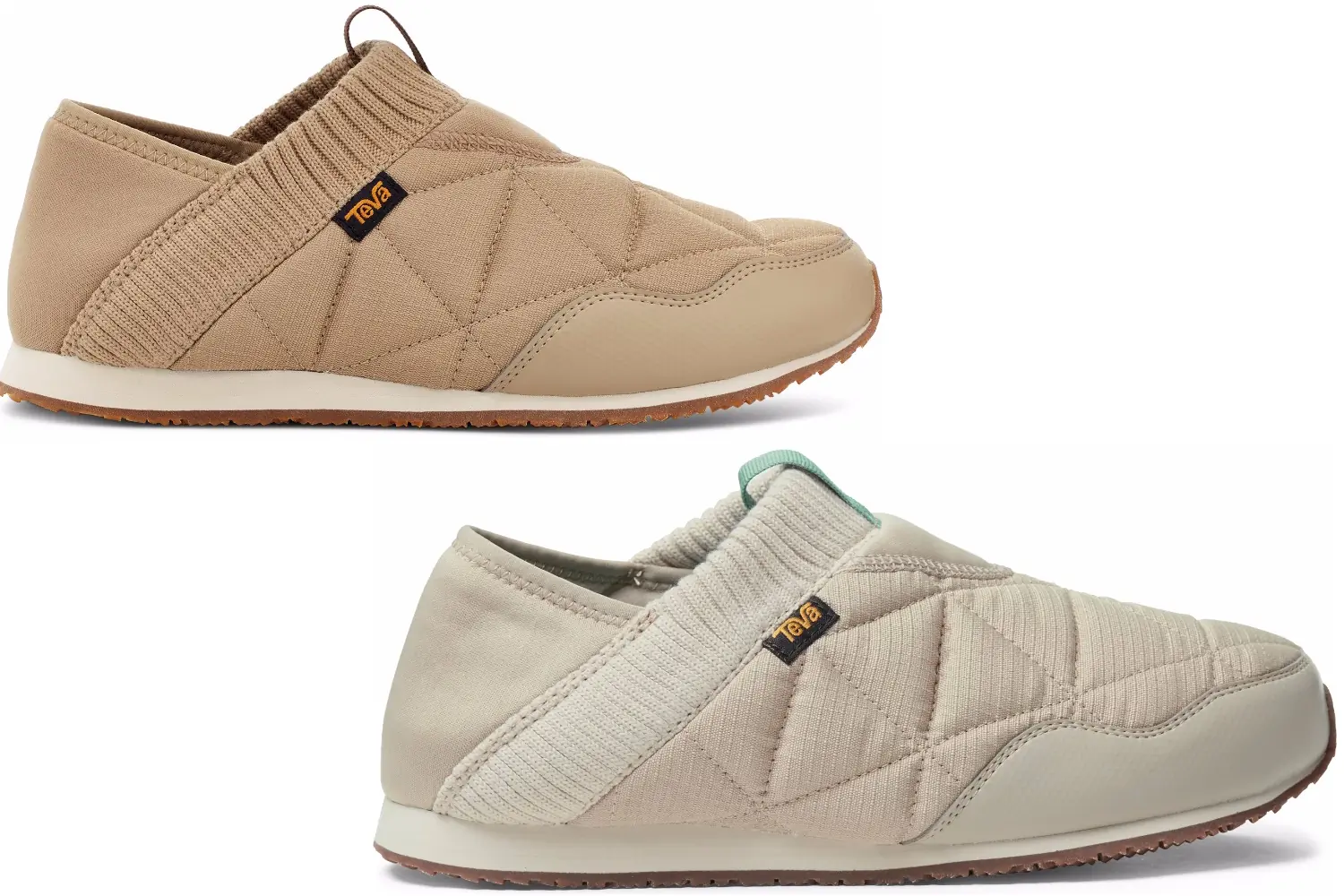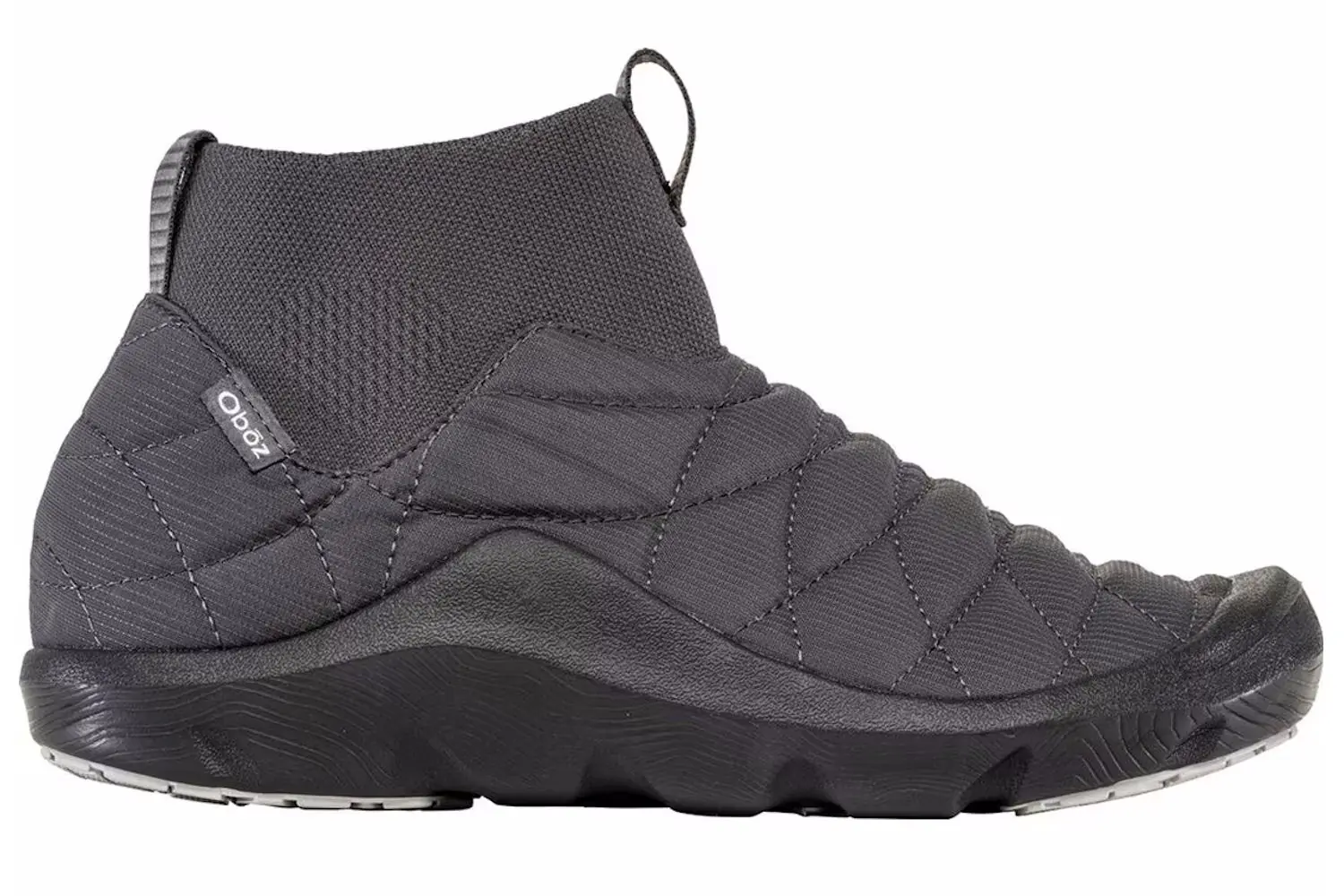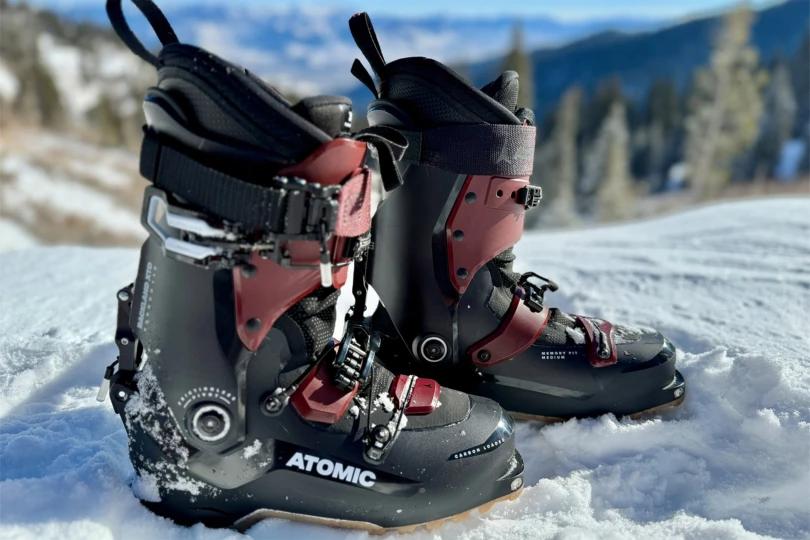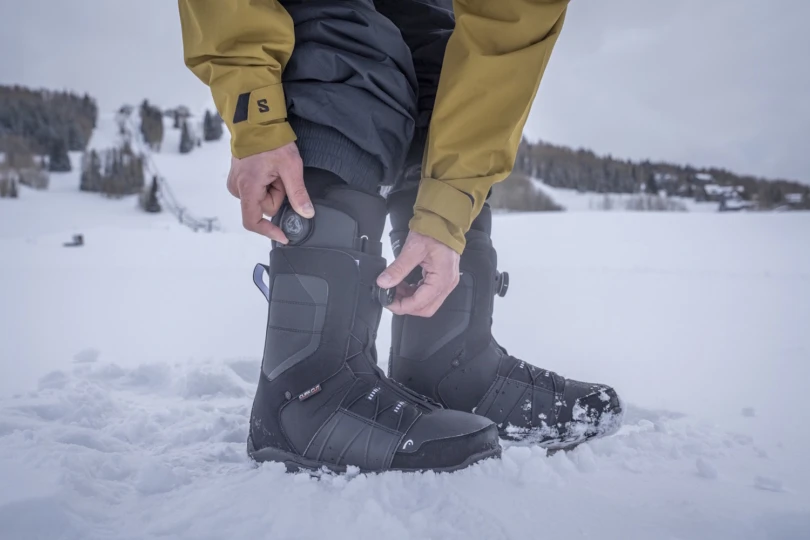When temperatures fall, keeping your feet warm becomes crucial. While regular slippers might get you by, the best down booties (or synthetic as the case may be) provide serious warmth in a lightweight, packable design made for true winter living. Whether you’re heading out on a ski trip, road-tripping to the slopes, or just trying to stay cozy on cold hardwood floors, booties keep your feet insulated and comfortable when it matters most.tun
This guide includes both natural down and synthetic-insulated options. Down delivers an unmatched warmth-to-weight ratio, while synthetic insulation tends to resist moisture better and costs less.
Some models, like The North Face Thermoball Traction Booties, offer more structure and grip for quick outdoor trips. Others, like the ultralight Baffin CUSH Booty, focus on packability and indoor comfort.
We’ve tested these booties in snowy parking lots, frozen cabins, and cold mountain camps to find the best options. Updated regularly since 2021, this guide covers reliable choices for every winter adventure.
Editor’s Note: On August 14, 2025, we added the Stio Colter Mountain Slip for its stylish camp-to-town design, the Outdoor Research Tundra Trax Booties for their versatile warmth and rugged sole, and the Western Mountaineering Expedition Booties for unmatched insulation in extreme cold.
The Best Down Booties of 2025
The North Face ThermoBall Traction Booties
- Insulation: 600-fill ThermoBall Eco Insulation
- Weight: 482 g
- Tread: Yes, recycled rubber sole
- Waterproof: No — water-resistant with DWR
- Best use: Daily outdoor use on snow and trail
Pros
- Tread allows for heavy outdoor use
- Durable in terms of structure and quality
- ThermoBall Eco technology allows for warmth to be retained even if wet
- Mostly made of recycled materials
Cons
- Not as packable or light as the other down bootie options
- More exposure to the ankle area due to low-profile design
Baffin Cush Booty
- Insulation: Fixed PolyWool. Nylon filled with wadding, cotton, and a PolyWool footbed insulation
- Weight: 312 g
- Tread: Sticky rubber soft sole
- Waterproof: No. B-Tek Dry water-resistant
- Best use: Indoor use on hardwood floors
Pros
- Sticky sole adds slip-resistance for walking around smooth surfaces
- Excellent loft
- Closing the ankle cinch helps keep warmth in
- Water-resistant
Cons
- A bit bulky when on your feet
- Wide fit might not be ideal for everyone
- Not super for extended outdoor use due to lack of underfoot structure
Western Mountaineering Expedition Booties
- Insulation: 800-fill goose down
- Weight: 226 g
- Tread: Non-slip Toughtek
- Waterproof: Yes. Gore Windstopper Shell
- Best Use: Extreme cold, winter camping, expeditions, mountaineering basecamps
Pros
- Extremely warm
- Durable, wind-resistant shell
- Structured sole & high snow-proof gaiters
Cons
- Pricey
- Overkill for many trips
- Bulkier than ultralight options
Outdoor Research Tundra Trax Booties
- Insulation: Polyester Primaloft Gold Insulation With Cross Core Technology 200 G/M²
- Weight: 456 g
- Tread: Synthetic rubber sole
- Waterproof: No. 100% recycled Pertex Quantum Eco water-resistant upper
- Best use: Winter camping, hut trips, cold-weather basecamp wear
Pros
- Warm and weather-resistant
- Grippy sole for outdoor use
- Structured and durable
- Good value for cold camps
Cons
- Bulkier than down booties
- Not for extreme cold
- Cinch cord loosens over time
Stio Colter Mountain Slip
- Insulation: 150 gm synthetic insulation/fleece lining
- Weight: 500 g
- Tread: Traction Rubber Outsole
- Waterproof: No. Water-resistant.
- Best Use: Winter camp wear, mountain town lounging, cold-weather cabin or van life
Pros
- Warm and weather-resistant
- Grippy sole with good structure
- Easy slip-on design
- Stylish enough for town wear
Cons
- Less warm than full down booties
- Bulky for backpacking
- Not ideal for extended walks or deep snow
Rab Down Hut Slipper
- Insulation: 700-fill recycled goose down
- Weight: 198 g
- Tread: None but has a nonslip sole
- Waterproof: No, water resistant
- Best Use: Backpacking and travel for packability
Pros
- Eco-friendly design
- Grippy sole for safer steps indoors
- Soft fleece lining for maximum comfort
Cons
- Ankle height might not be the coverage you need
- Opening is not adjustable
Line Bootie 1.0
- Insulation: Synthetic
- Weight: Unavailable
- Tread: Michelin rubber outsole
- Waterproof: No
- Best Use: Outdoor use on pavement, trail, and snow
Pros
- Great Traction
- Stylish
- Super warm
Cons
- Can be a bit too warm when wearing indoors
- Looser fit around ankle means they can slide off a bit while walking up stairs
More Down Booties We Loved
- Insulation: Foam quilt insulation
- Weight: 481 g
- Tread: Yes, VertiGrip rubber outsole (25% recycled)
- Waterproof: No
- Best use: Car camping, strolls around town
Pros
- Easy to throw on
- Durable tread for outdoor use
- Extremely comfortable and cushioned
- Ideal amount of insulation for indoor and outdoor use
- Cool aesthetic
Cons
- Not waterproof
- Only offered in whole sizes
- Lack of heel closure can cause moisture to penetrate
- Insulation: Premium goose down, 850-fill (standard) and up to 1,700-fill (custom)
- Weight: 58 g
- Tread: None
- Waterproof: No, but waterproof overbooties can be added
- Best use: Winter camping inside a sleeping bag
Pros
- Customized warmth, durability, and look
- Size run includes XS to 2XL
Cons
- Husky aesthetic
- Custom down socks require an average 2-week turnaround to process and ship
- The down socks alone are not ideal for outdoor use (but the Waterproof Over Booties should do the trick)
- Insulation: 550-fill DriDown (natural down treated with a hydrophobic finish)
- Weight: 269 g
- Tread: None, flat sole with silicone material for added grip
- Waterproof: No, water resistant with DWR
- Best use: Hut trips and backpacking excursions for their packability
Pros
- 550 fill DriDown insulation is warm but also quick-drying and moisture-wicking
- Cinch cords above ankles allow for further insulation
- Packable and lightweight
- Tricot liner is soft on the feet
Cons
- Not suitable for a ton of outdoor use with lack of tread
- Sizing can be variable since they are not numerical
- Insulation: 200 g PrimaLoft synethic
- Weight: 539 g
- Tread: waffle outsole
- Waterproof: No
- Best use: On dry trail or around town
Pros
- Heavy duty tread is great for use on trail and off
- Converts from shoe to slipper
- Swappable insole
Cons
- Not comfortable for folks with high arches
- No waterproofing
- Insulation: 200 g 100% polyester Primaloft Alternative PrimaLoft Aerogel
- Weight: 156 g
- Tread: None, soft and grippy sole
- Waterproof: No, water resistant
- Best use: Mostly indoor with minimal outdoor
Pros
- Taller cut
- Synthetic insulation provides warmth even when wet or damp
- Ankle cinch tops
Cons
- Down fill sets the bar for warmth
- Insulation: 100% Polyester (recycled)
- Weight: 201 g
- Tread: None, thin rubber sole
- Waterproof: No, water resistant with DWR treated exterior
- Best use: Indoors or short trips around camp
Pros
- Lightweight and packable
- Made with 100% recycled materials
- Full coverage
Cons
- Lack of arch support
- Leg cuff may be too tight for some
- Synthetic: 200g 100% post-consumer recycled FireLine Eco synthetic insulation
- Weight: 170 g
- Tread: None, textured sole
- Waterproof: No, water-repellent finish
- Best use: Backpacking and at the campground
Pros
- Drawstring ankle cuff provides custom fit and insulation
- Textured sole ideal for indoor use
- Easily packable
Cons
- Lack of tread
- Not waterproof
- Insulation: 100% synthetic Vegan down alternative
- Weight: 213 g
- Tread: Yes, 50% recycled rubber outsole
- Waterproof: Water resistant
- Best use: All-season outdoor and indoor
Pros
- Can convert from a shoe to slipper
- Tread allows for multi terrain use
- Wide array of versions and colors
Cons
- Not super breathable
- Only available in whole sizes
- Insulation: Freeze Guard 100g insulation (100% post consumer recycled polyester)
- Weight: 309 g
- Tread: rubber compound
- Waterproof: No, water-resistant with DWR-treated upper
- Best use: Casual wear around camp and town
Pros
- Comfortable footbed suitable for standard to wide feet
- Ultra-lightweight design
- Environmentally friendly
- Tread is perfect for use outdoors and in
Cons
- Whole sizes only
- Not as lofty as a standard down booty
Down Booties Comparison Chart
Scroll right to view all of the columns: Price, Down, Fill, Weight.
| Down Booties | Price | Insulation | Fill | Weight |
| The North Face Thermoball Traction Booties | $69 | ThermoBall Eco Insulation | 600-Fill | 482 g |
| Baffin CUSH Booty | $60 | Fixed PolyWool | N/A | 312 g |
| Western Mountaineering Expedition Booties | $170 | goose down | 800-fill | 226 g |
| Outdoor Research Tundra Trax Booties | $99 | Polyester Primaloft® Gold Insulation With Cross Core Technology 200 G/M² | N/A | 456 g |
| Stio Colter Mountain Slip | $139 | 150 gm synthetic insulation/fleece lining | N/A | 500 g |
| Rab Down Hut Slipper | $65 | Recycled goose down | 700-fill | 198 g |
| Line Bootie 1.0 | $70 | Synthetic | N/A | N/A |
| L.L.Bean Mountain Classic Quilted Ankle Boots II | $99 | Foam quilt insulation | N/A | 481 g |
| GooseFeet Gear Down Socks | $69-97 | Premium goose down | 850-fill (standard), up to 1,700-fill (custom) | 58g |
| Sierra Designs Down Booties | $80 | DriDown (goose) | 800-fill | 269 g |
| Danner Jag Loft | $75 | 200 g PrimaLoft synethic | N/A | 539 g |
| Outdoor Research Tundra Aerogel Sock | $75 | PrimaLoft Aerogel | PrimaLoft Aerogel | 156 g |
| Montane Icarus Hut Boot Style Slippers | $90 | 100% Polyester | N/A | 201 g |
| Big Agnes Full Moon Camp Synthetic Booties | $70 | FireLine ECO Synthetic Insulation | N/A | 170 g |
| Teva ReEMBER | $80 | 100% synthetic vegan down alternative | Synthetic down alternative | 213 g |
| Oboz All Gender Whakatā Puffy Mid | $110 | Freeze Guard 100g insulation (100% post-consumer recycled polyester) | N/A | 309 g |
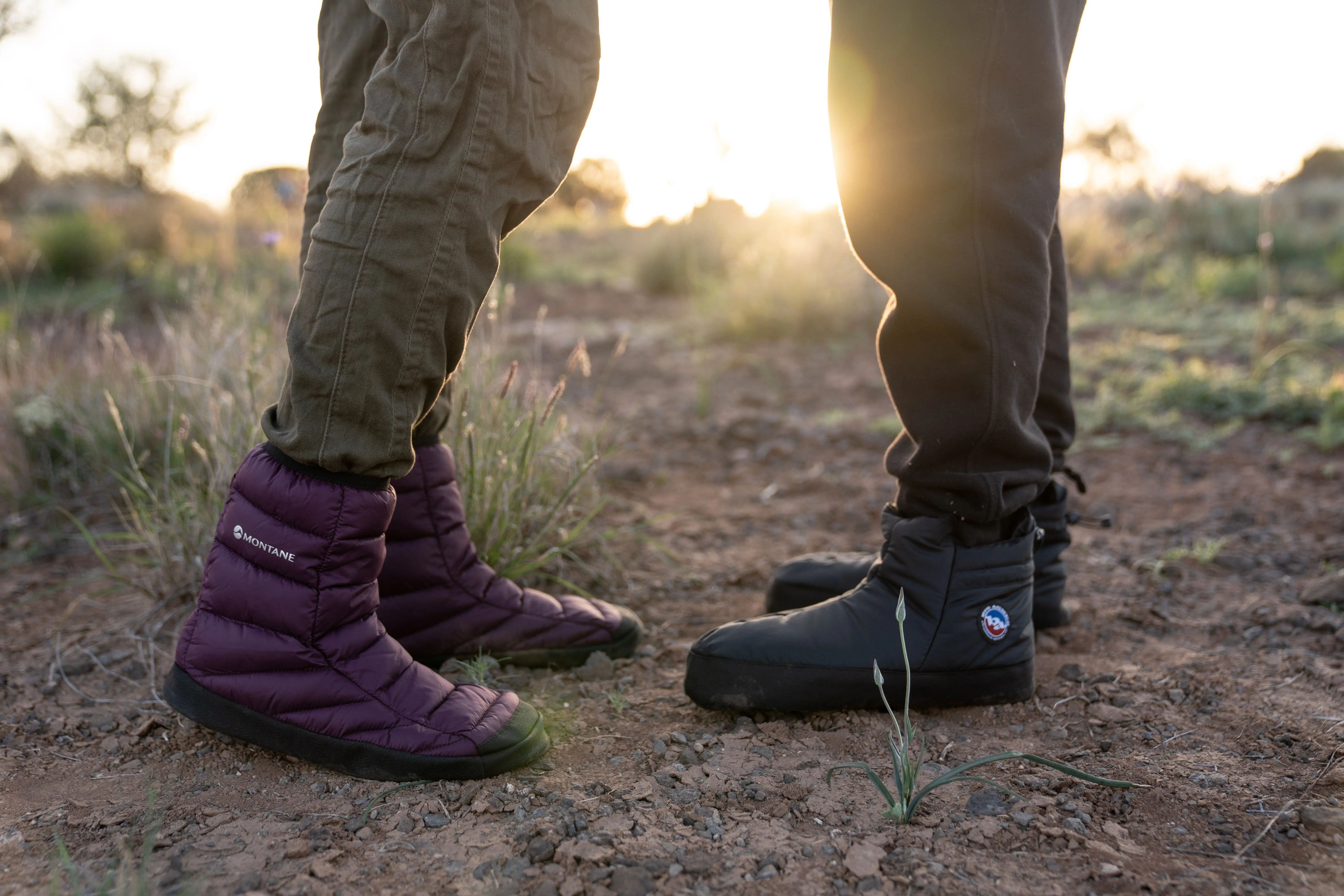
How We Tested Down Booties
The GearJunkie squad uses down and synthetic-fill booties and socks on outdoor adventures year-round. We use them camping and backpacking, on ski hut trips, ski resort commutes, and for everyday use in our chilly — sometimes freezing — mountain-based offices and homes.
Our Expert Testers
Leading the testing squad for down booties is GearJunkie contributor Meghan LaHatte. On average, LaHatte wore each pair of down booties for at least 20 hours, including 1.5-mile daily outdoor walks to examine the tread. During testing, temperatures ranged from 15 to 55 degrees Fahrenheit. While she mostly walked on pavement, she also tested the more rugged designs on snow, ice, and the occasional patch of mud to check their waterproofness. For example, in the L.L.Bean Women’s Mountain Classic Quilted Booties, LaHatte walked nearly two miles in powdery snow. She found herself in a mixed bag of snow, wind, rain, and sleet — you name it!
Other testers include Senior Editor Morgan Tilton and editor, Chris Kassar.
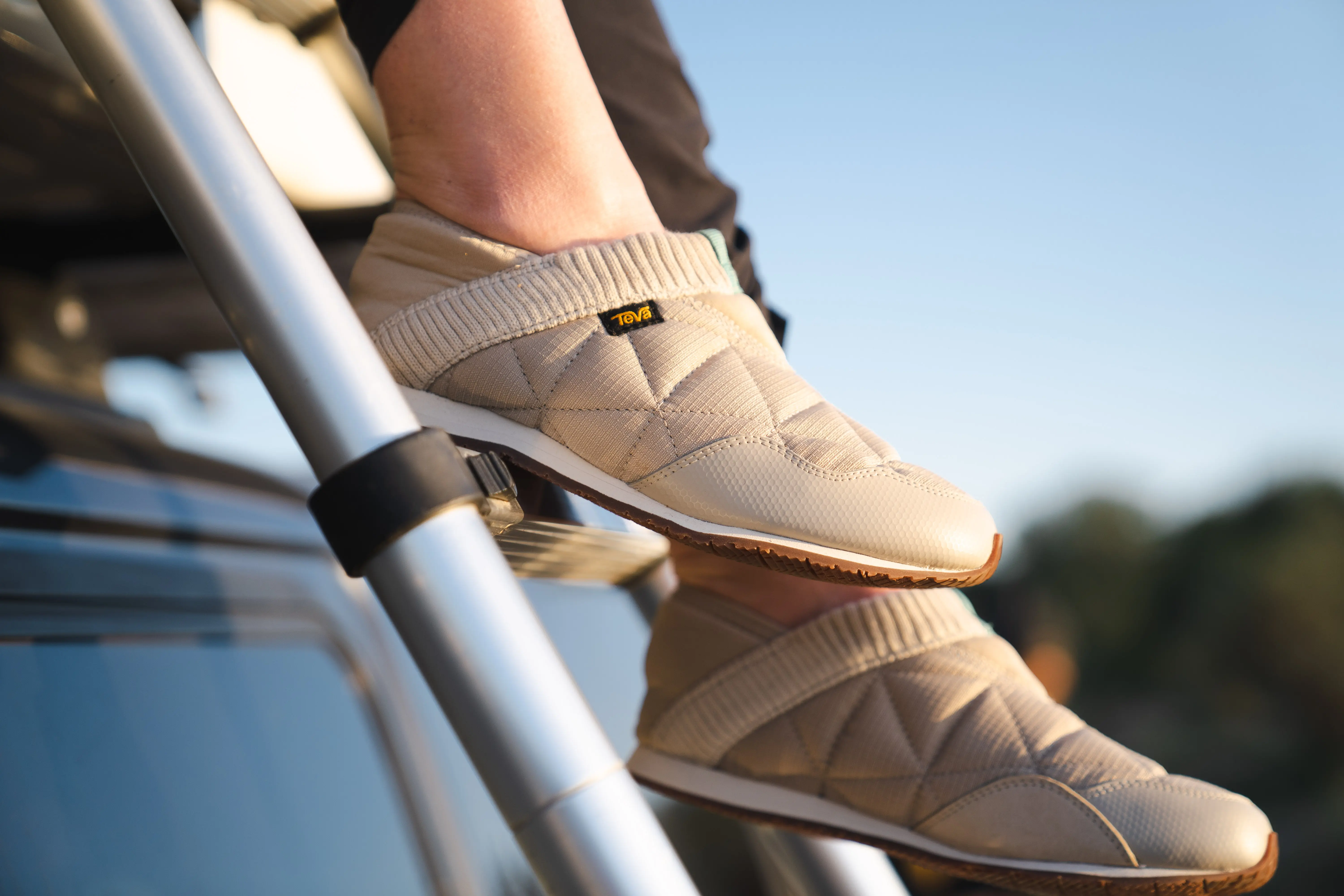



Our Testing Grounds
Having lived in one of the coldest regions of Colorado for the past 5 years, LaHatte is no stranger to cold feet. After suffering from a chronic foot injury due to a nasty case of frostnip, she understands the importance of keeping her feet well-insulated both indoors and out. LaHatte tested these down booties on frigid dog walks, working in her home office, camping in the desert, and transitioning into her ski boots before and after deep powder days.
Our Testing Process
Our team tested down and down-alternative booties and socks from the early fall to late winter in temps from -10 to 40 degrees. We also used them for fall and winter camping, après skiing, around the house, and more.
Throughout our field tests and personal experience, we determined the best down booties and down socks based on a variety of metrics including insulation, value, warmth, durability, comfort, overall fit, cuff height, cuff closure, adjustability, traction, tread and outsole, midsole support, anti-odor treatment, heel tab, style, and quality.
Beyond our tests, we also considered the most popular, award-worthy, innovative, sustainable, and legacy designs. These down booties serve a range of feet, applications, and budgets.
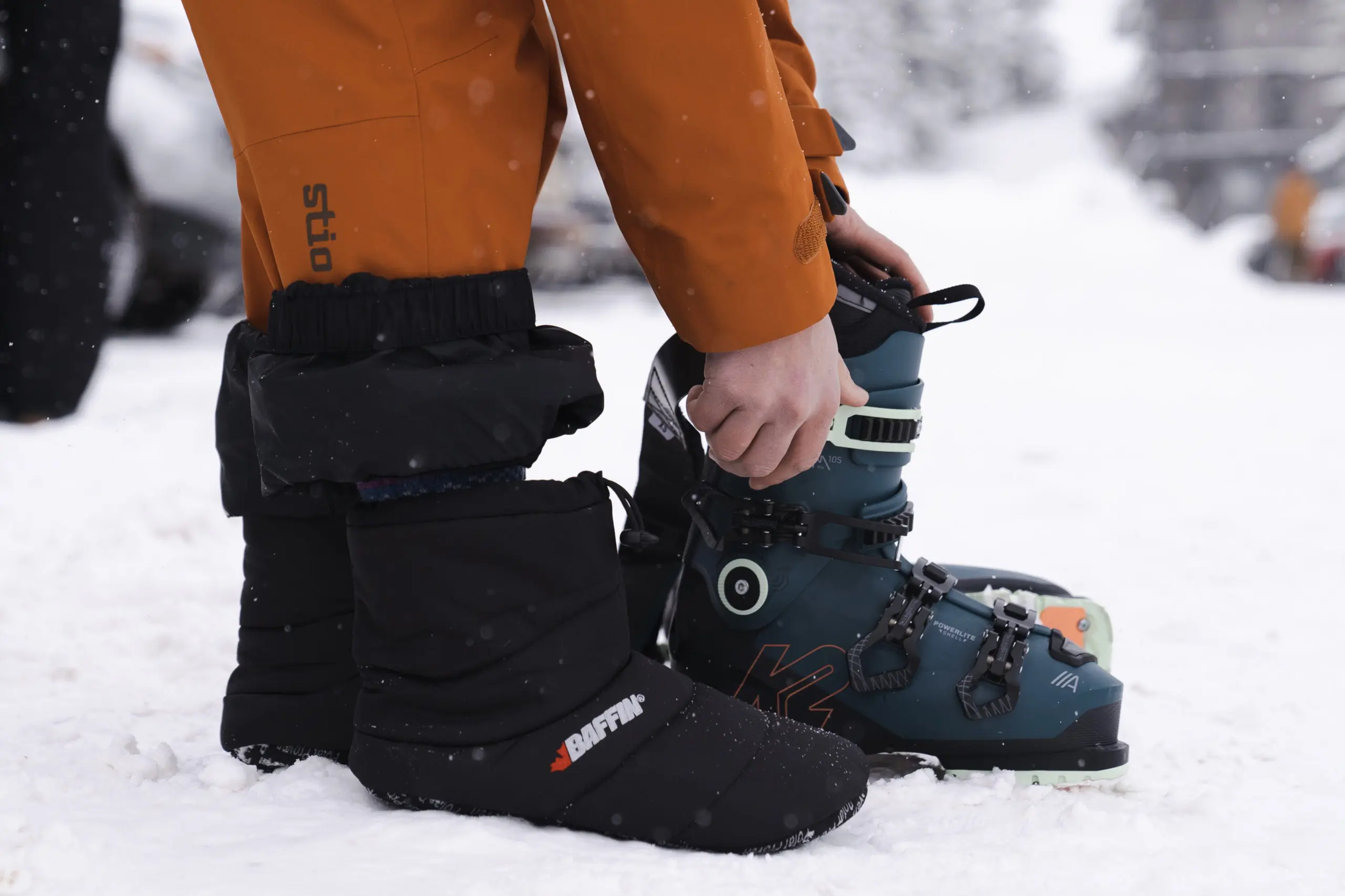



Buyer’s Guide: How to Choose Down Booties
Down Booties vs. Down Socks
Differences
There are only a few slight differences between down booties and down socks. Down booties are a type of shoe with an insulated body, insulated sole, and some sort of closure at the top to seal in warmth. They can be ankle-height to mid-calf-height to insulate your whole foot.
Down socks are also fully insulated but may or may not have a sole and usually don’t have snaps, closures, or other features. They’re purely for providing warmth. Down socks also tend to be made of lighter, lower-denier fabrics, as they’re used more inside sleeping bags rather than walking around a house or cabin.
Uses
Down booties are the most common way of insulating your feet in winter and are usually more versatile and durable, though we did include a few down socks on this list as well. If you plan on wearing your down booties outside and adding some mileage to them, we suggest buying a pair like the Western Mountaineering Expedition Booties with a thicker sole and grippy tread for traction.
When you’re shopping for down footwear, think about where you’ll be wearing the booties and how much durability you might want. Do you want an insulating slipper with a sturdy sole? Or do you want something with fewer shoe features, maybe to wear inside your sleeping bag? Or, do you want a stylish bootie like the Stio Colter Mountain Slip that will move easily from camp to town.
Do you want a taller-height bootie or more of a slipper style? Down booties can be worn with or without socks, but we suggest a thinner and breathable sock if you choose to go that route. The booties themselves are typically warm enough that there is no need to pull on a thick or 100% wool sock.
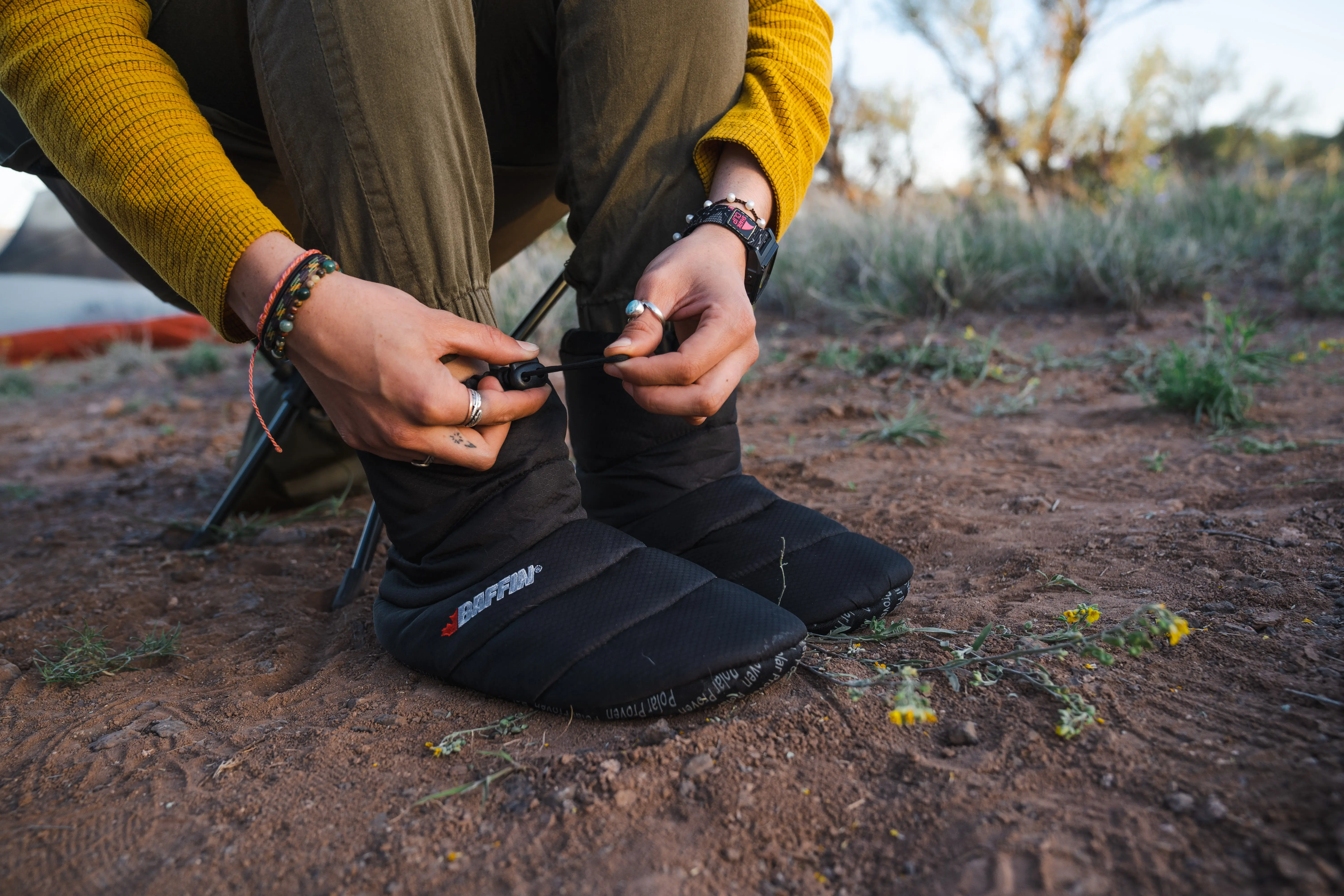



Materials
Our comprehensive guide includes a wide variety of down bootie styles, ranging from various types of soles, insulation, fits, and materials. With so many different types of booties on the market, it can be hard to differentiate between what styles are meant to be worn inside, out, in a sleeping bag, as socks, etc. It really all boils down to what kind of materials the down booties are made of and their intended use.
We’ve outlined the various materials and their purposes below to help guide your search for the perfect bootie type.
Exterior Fabrics
The exterior fabric of down booties is an important component to consider when shopping for a pair. The exterior fabric is what protects the overall shoe from various elements and can help improve the insulation abilities of the interior as well.
Most down booties are constructed with a nylon exterior. Nylon is a synthetic material made to be tear and water-resistant. It is typically lightweight and breathable, depending on the stitching. Nylon is used because it is versatile and can help the down booties maintain their best insulation abilities, thus keeping your feet toasty warm. The Baffin CUSH Booty utilizes reinforced nylon, making it both durable and water resistant.
You will also see down booties designed with a quilted upper, like the Teva ReEMBER and Oboz All Gender Whakatā Puffy Mid. Quilted exteriors keep the insulation from shifting around too much, thus allowing the insulation to retain heat even better than before. Think about how warm your childhood quilt was as a kid — basically the same science!
Most fabric exteriors of down booties have hydrophobic properties making them waterproof or water-resistant. If you want to garner more knowledge about those applications, keep scrolling.
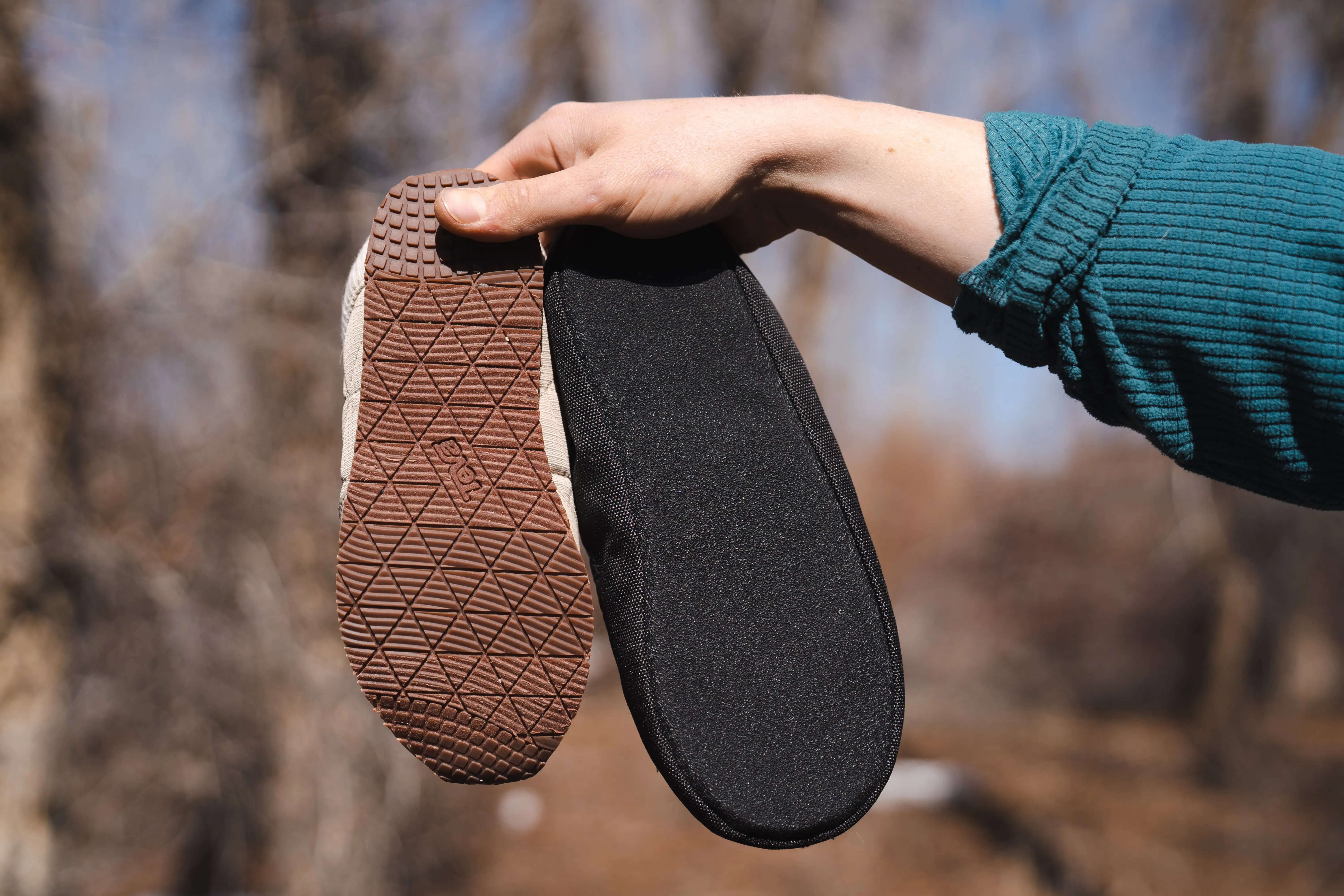



Tread
If you’ve scrolled through our list of down bootie options, you likely noticed that some of these products have outsole tread while others have little to none. Tread sets the bar on how much mileage you can get out of a pair of down booties.
Booties with softer soles that lack tread should be worn indoors, like in a cabin or hut. You can treat these shoes like your standard house slippers. Yes, you could probably run out in the driveway to fetch the paper in them, but you wouldn’t want to hit the trails since they lack the arch support or durability to support your feet on varying terrain. Our choice for the best tread-less option? The Montane Icarus Hut Boot Style Slippers perform super well for indoor use.
Some down booties are built for exploring, like the North Face Thermoball Traction Booties, the Outdoor Research Tundra Trax Booties and Danner Jag Loft. These puppies have a thick rubber sole with added texture so you can keep your feet warm while stepping over snow, rocks, and in and out of your ski boots. While the extra amount of tread is ideal for outdoor use, they aren’t great for sticking in your sleeping bag or kicking back in your apartment due to the bulkiness.
Overall, when thinking about tread, it is important to consider how and where you’ll be rocking your down booties. Are you someone looking for a house slipper? Or are you going to hit the town in them for some après fun?
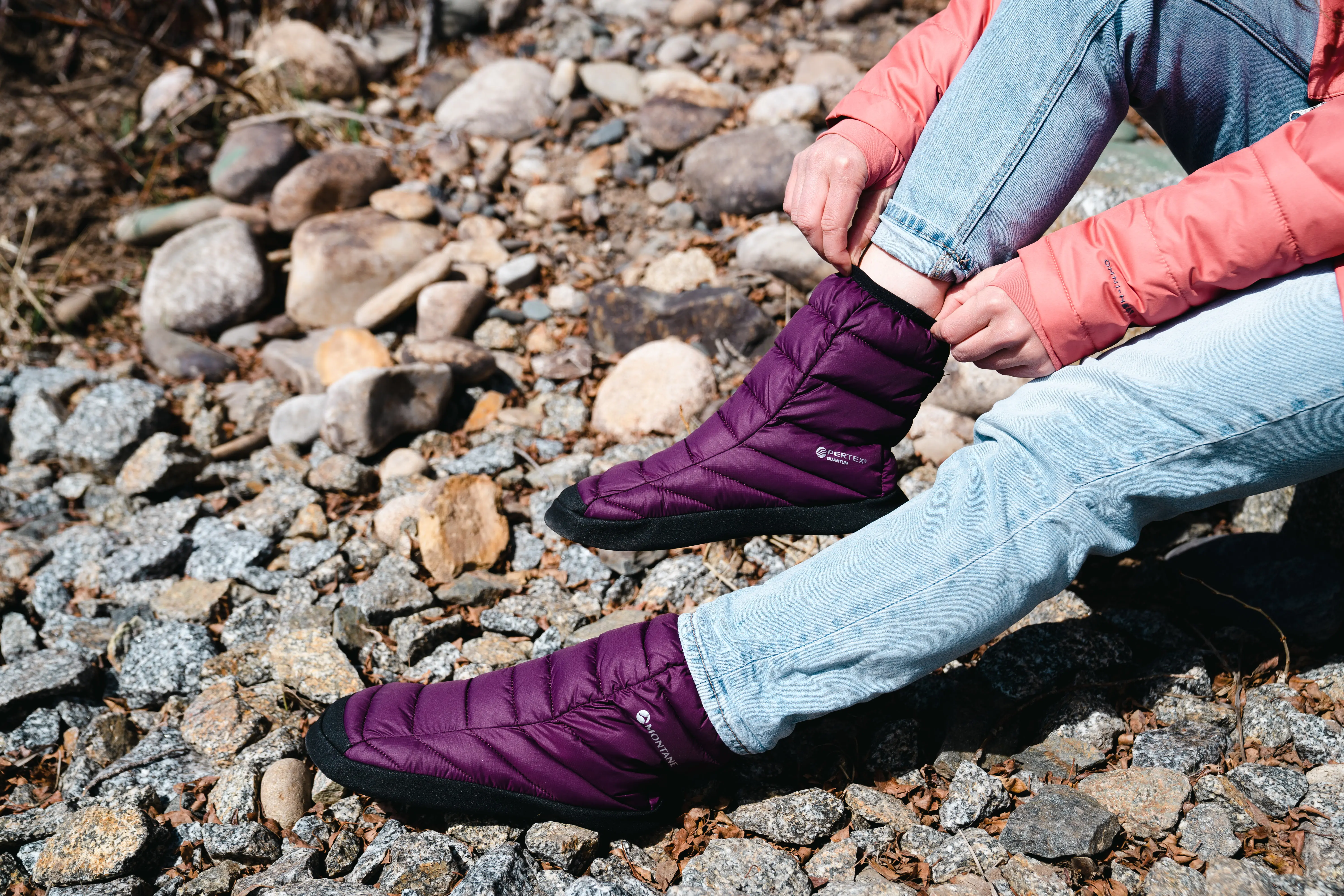



Insulation
Similar to down jackets, the level of warmth of a down bootie largely depends on its insulation. A down bootie with 800-fill is going to be much warmer than a down bootie with 600-fill. The most common type of fill we see used in down booties is either goose down or a synthetic alternative.
Natural Down Insulation
Made from goose or duck feathers, natural down insulates by the loft of the feathers creating pockets of hot air. It is highly effective in keeping the user’s feet warm and insulated while still being lightweight and packable.
However, natural down tends to be more pricey and may not be as ethically sourced as one would like. We can assure you that all the down booties listed in this guide come from companies aiming to end abuse in the down supply chain.
Down also tends to lose its insulation abilities when wet and takes longer to dry. Because it is made with feathers, it can also be a bit harder to wash due to exposure to water, which causes it to lose some loftiness. Be sure to check your down booties’ care tag before washing them to ensure their longevity.
Made with a natural goose down, the Rab Down Hut Slipper was one of our favorites in this category. Because of the natural down, they are more packable and tend to have a better warmth-to-weight ratio than synthetic options.




Synthetic Insulation
Tending to be more accessible in price and availability, synthetic-stuffed booties are also a great option for someone wanting to keep their toes warm without breaking the bank or worrying about animal byproducts. Often, the word “down” is associated with an insulation material, but don’t let that confuse you.
Typically made with polyester or nylon materials, synthetic booties can provide just enough insulation and durability so you can stay comfortable out in the cold. They also tend to be lightweight, making them easily packable for any excursion.
When synthetic insulation is exposed to moisture, the warmth factor still performs well and dries faster than natural down. However, synthetic fill is inherently less warm than natural down, so it is important to keep that in mind when choosing your down booties and where you’ll wear them.
Our favorite synthetic-fill options include the Outdoor Research Tundra Aerogel Sock. Made with 100% polyester Primaloft, they kept our feet just as warm as some of the other natural down bootie options, and because they are made with synthetic insulation, they are reasonably priced for their durability.
The type and thickness of the bootie lining, as well as the material and height of the bootie, will also factor into its warmth and insulation abilities.
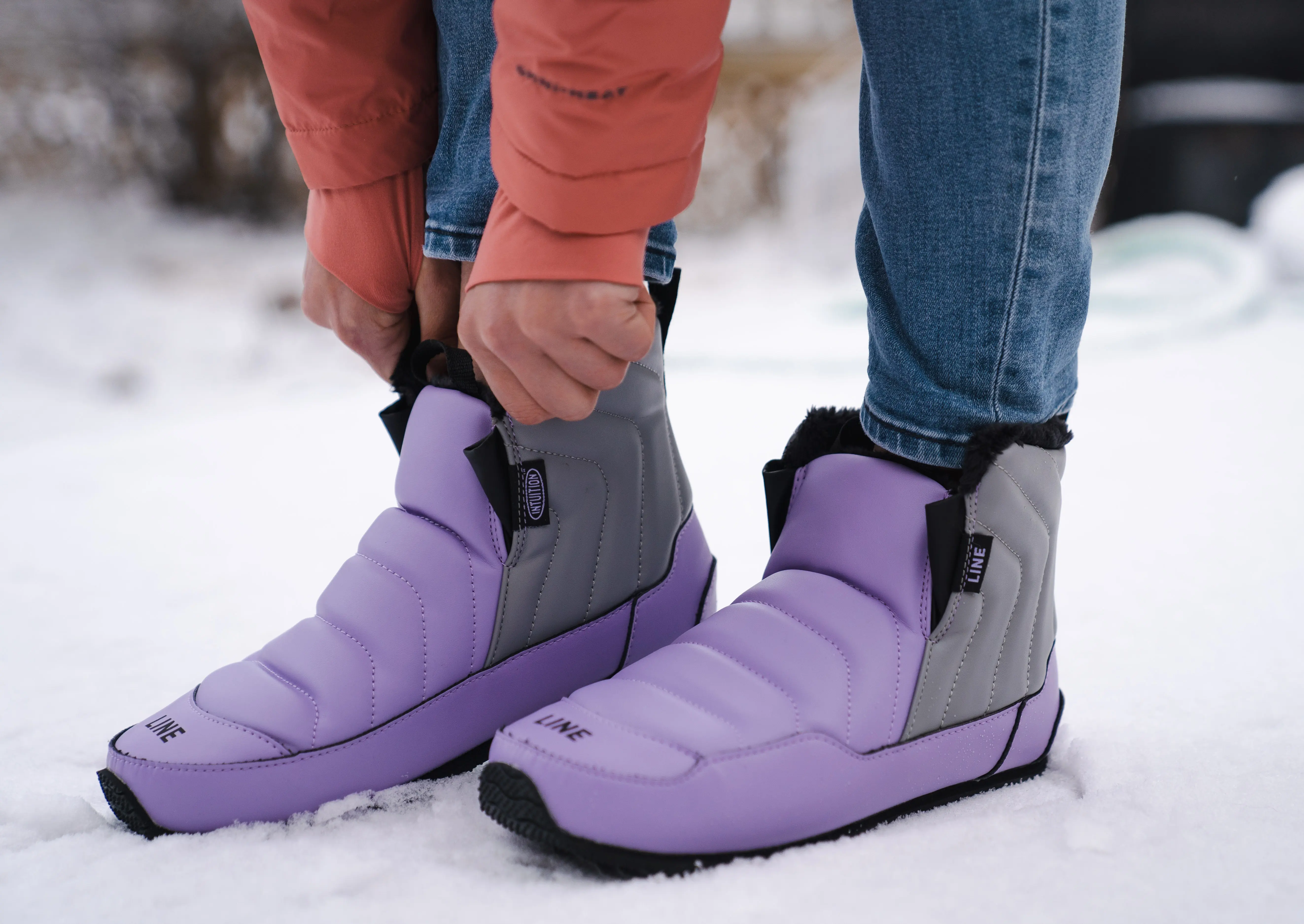



Warmth
The warmth of a down bootie is influenced by the type, quality, and quantity of the fill. Other variables play a role, including the height, depth of the outsole, water resistance, liner, and exterior material.
The fill type (down or synthetic) and its amount are typically the most influential factors on a pair of down booties’ warming abilities. Natural down fill is typically more warming than a synthetic alternative, but it can lose its loftiness when wet. A synthetic fill will be less warming but does better if exposed to moisture. However, with major innovations in synthetic insulation, alternative down fills are becoming better.
Another aspect of warmth in a down bootie we want to highlight is its cuff height and sole thickness. We found that the down booties with higher cuffs with added closures were much better at keeping our feet warm than those without. However, if closed too tight or with too much of a slim fit, circulation can be cut off, leading to a loss in insulation. Furthermore, down booties with higher, thicker soles helped keep our toes warmer since they were more elevated above and well insulated from the floor. For example, the Rossignol Women’s Chalet Shoes’ thick rubber soles helped keep our feet plenty protected from the snow-covered ground.
Typically, brands assign their products a warmth level or temperature rating, especially for winter wear. Some of these booties have been given these ratings, whereas others we determined ourselves.
To help you navigate the complexities of warming abilities in down booties, we’ve categorically sorted them into three levels of warmth in order of least warming to greatest warming.
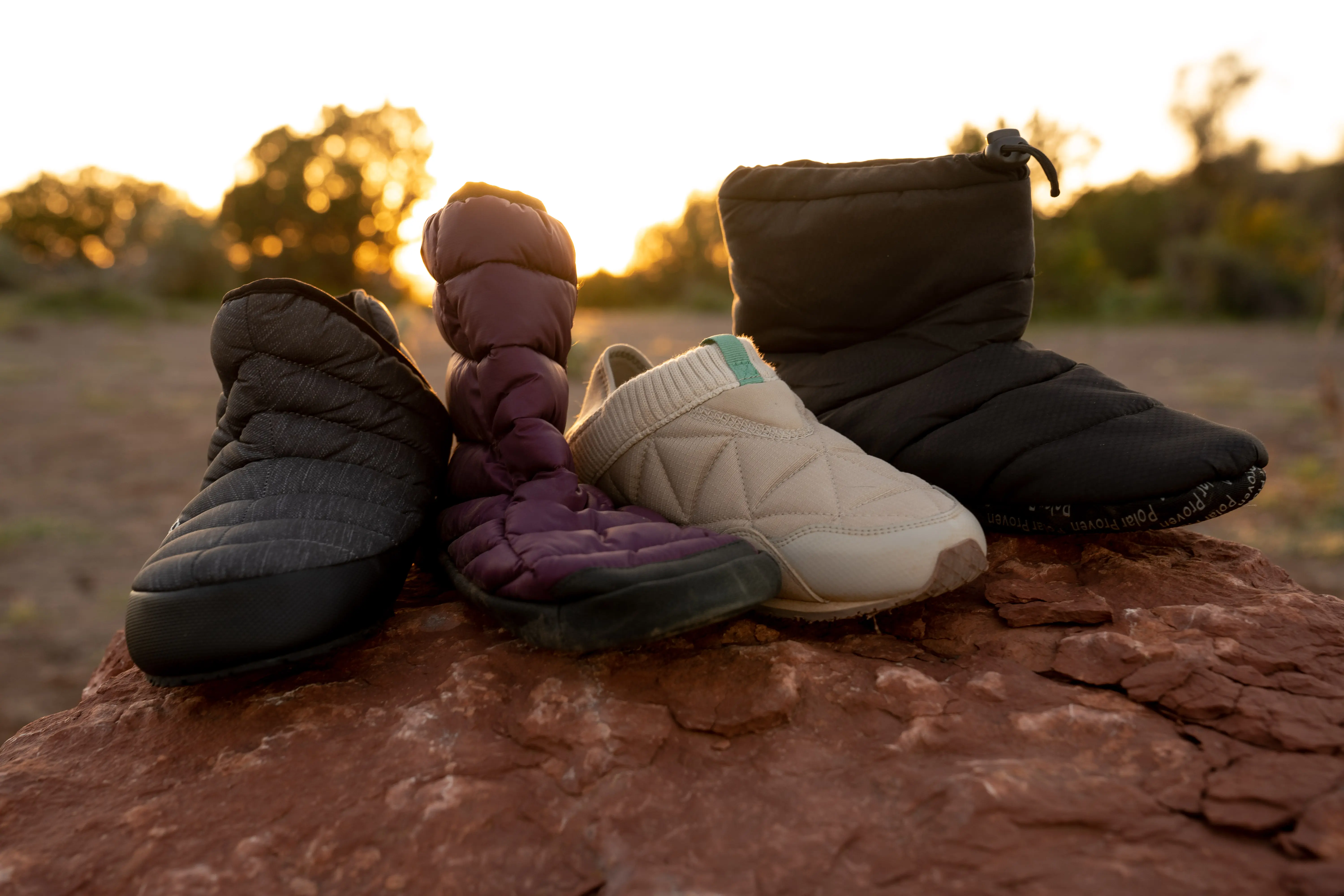



Warmth Level Based on Testing
Level I. These down booties are best suited for mild winter climates where you don’t see significantly low temperatures. These are best for daily wear and can be worn seasonally, weather permitting.
- Teva ReEMBER
- L.L.Bean Women’s Mountain Classic Quilted Booties
- Montane Icarus Hut Boot Style Slippers
- Rab Hot Socks
Level II. These down booties are suitable for winter use in colder climates with consistently low temperatures, but not totally extreme. These can be worn while winter camping alongside a fire or in a backcountry hut.
- Outdoor Research Tundra Aerogel Sock
- Line Bootie 1.0
- Big Agnes Full Moon Camp Booties
- Oboz All Gender Whakatā Puffy Mid
- Rossignol Women’s Chalet Shoes
- Danner Jag Loft
- The North Face Thermoball Traction Booties
- Baffin CUSH Booty
- Rab Down Hut Slipper
Level III. Down booties with significant insulation amounts and durability and are designed for enduring more extreme, sub-freezing temperatures. These are best used in the dead of winter or while in a sleeping bag on a chilly camping night.
- Sierra Designs Down Booties
- GooseFeet Gear Down Socks
- The North Face Summit Advanced Mountain Kit Sleeping Sock
- Western Mountaineering Flash Down Booties
- Western Mountaineering Standard Down Booties
And while there is a standardized temperature rating scale for products like sleeping bags and down jackets, there has yet to be one created for down footwear. However, Goosefeet Gear has undergone testing to find these numbers out, and their down socks are rated from 15 to 35 degrees Fahrenheit, depending on the insulation amount the buyer chooses.
It’s important to remember that warmth is also subjective and unique to each individual, depending on their circulation, the weather, their health, and the given environment. But these lists can help point you in the right direction.
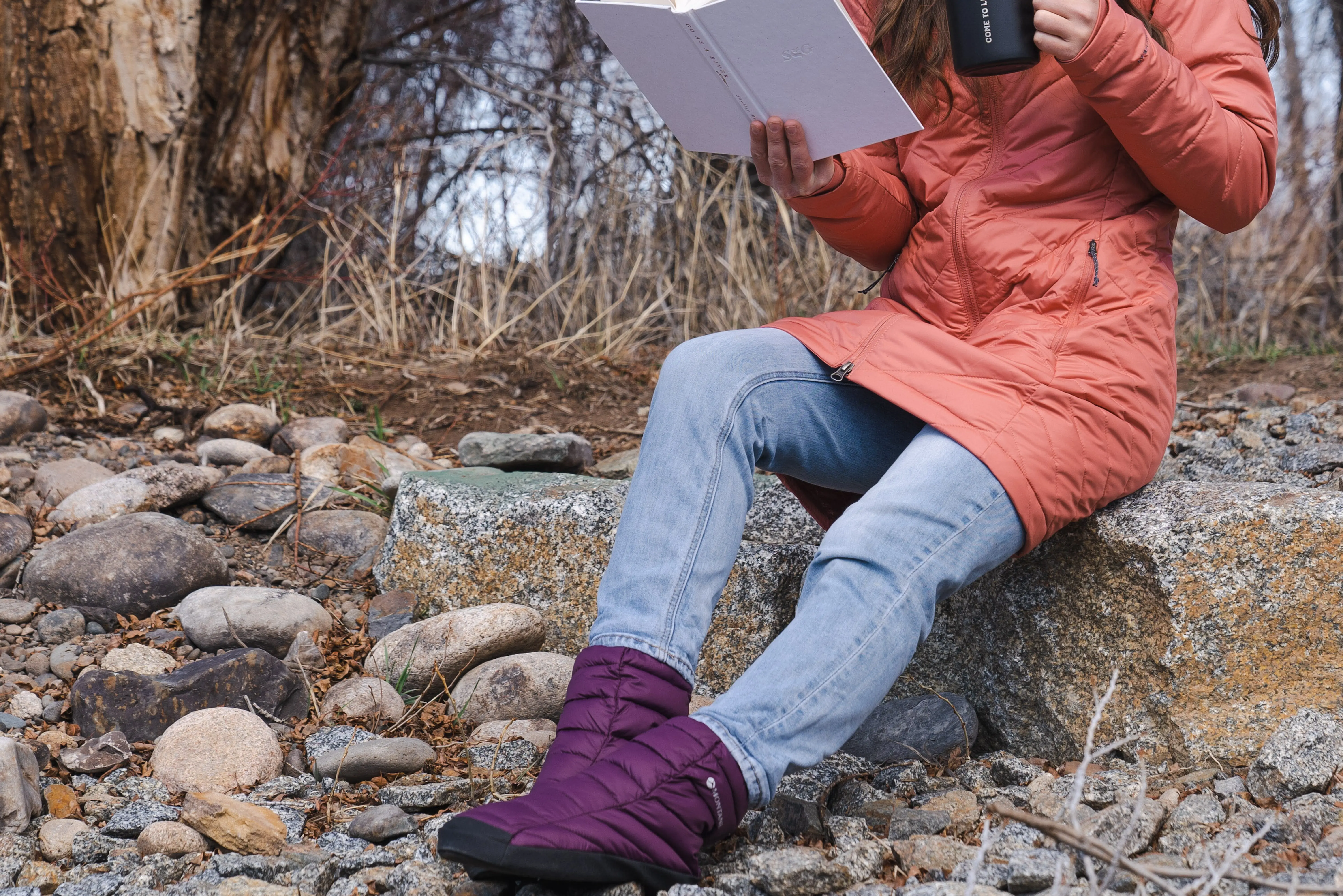



Waterproofness vs. Water-Resistance
If you’re planning on wearing your down booties in snow, rain, or sleet, you’ll definitely want to consider purchasing a pair that’s waterproof or water-resistant. Many of the options listed in this guide have varying degrees of water protection, some more than others.
Waterproof booties are made with materials and coatings that prevent any water or moisture from penetrating the fabric’s surface. Think materials like GORE-TEX or eVent that are treated with coatings that are hydrophobic and cause water to bead right off. While we don’t have any waterproof down booties specifically listed in this guide, we would recommend the GooseFeet Gear Down Socks combined with their Waterproof Over Booties if you’ll be in more wet environments while camping.
On the other hand, many down bootie options listed in this guide are water resistant, meaning they can repel water or snow off their surfaces to a certain degree. Materials that are water resistant are not completely impervious to water exposure but should do the trick if you’re walking in light rain or snow. Water-resistant fabrics are typically made with synthetic fibers like nylon and then treated with a liquid-repellent finish, like DWR (durable water-repellent). The Sierra Designs Down Booties are our favorite water-resistant down booties coated with DWR.
Here are our choice down booties that have been treated for water resistance:
- Sierra Designs Down Booties
- The North Face Thermoball Traction Booties
- Baffin CUSH Booty
- Teva ReEMBER
- Rab Down Hut Slipper
- Big Agnes Full Moon Camp Synthetic Booties
- Montane Icarus Hut Boot Style Slippers
- Western Mountaineering Standard Down Booties
- Oboz All Gender Whakatā Puffy Mid
- Rossignol Women’s Chalet Shoes
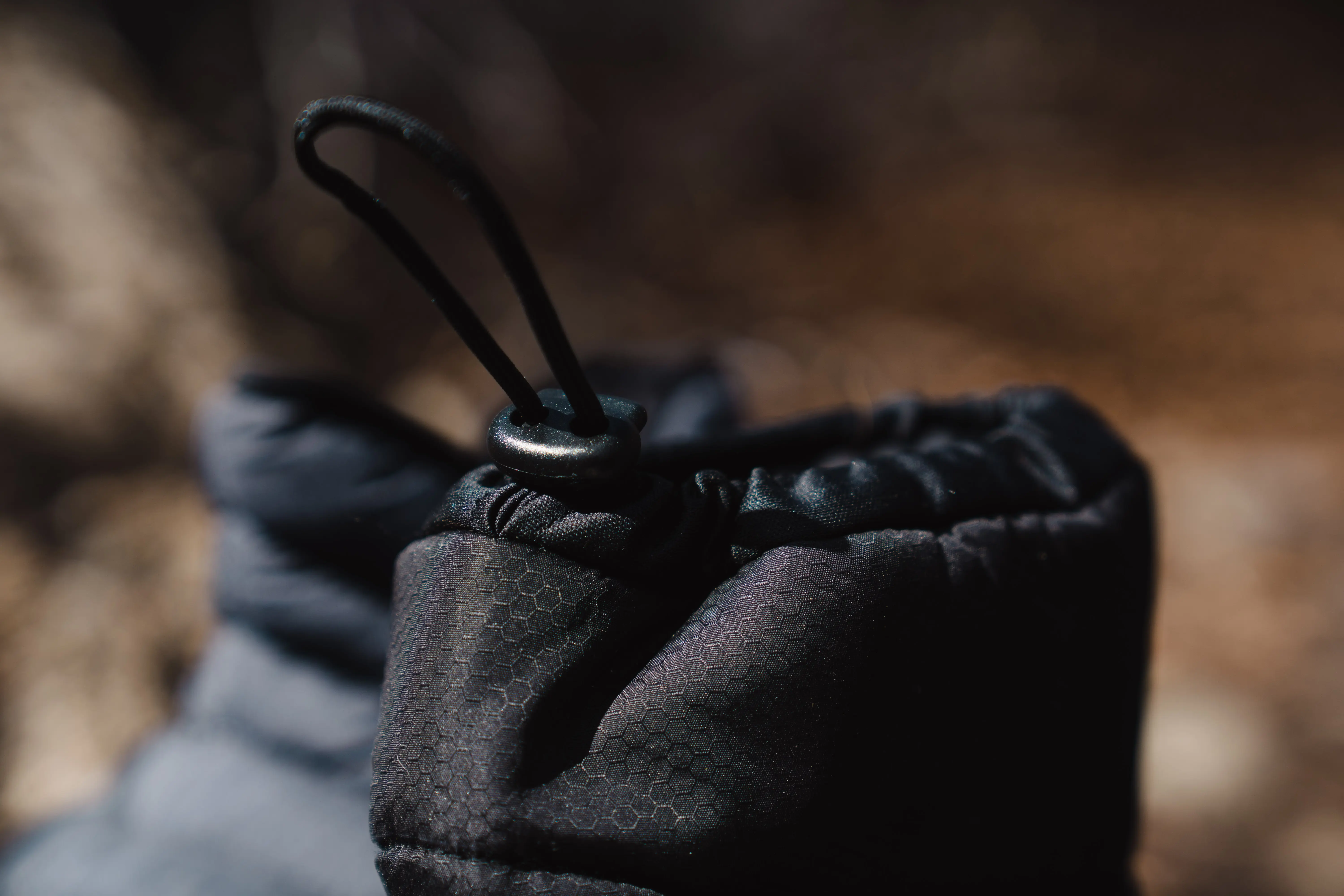



Cuff Height
A down bootie’s cuff height refers to the height or length of the upper portion of the booties that cover the ankle and lower leg. Different cuff heights in down booties offer varying levels of coverage and functionality. The options listed in this guide have lower ankle and mid-leg coverage options, but there are a few down bootie options on the market that provide protection all the way to the knee.
We particularly liked the above-ankle cuffs on the L.L.Bean Women’s Mountain Classic Quilted Booties for their coverage without adding any extra bulk. Not to mention, the heels of these booties also have an easy pull tap for quick on and off, so they are perfect tossing on after a long day on the skin track.
Low or Ankle Cuff
Down booties with a low or ankle cuff provide minimal coverage, typically ending just above the ankle bone. These booties tend to be lightweight and offer a greater range of motion. They are suitable for activities where maximum mobility and breathability are desired, such as inside or in warmer climates. However, their exposure provides less warmth and protection to the ankle area. Our choice for an ankle cuff down bootie is the Rab Down Hut Slipper, which is rather lightweight, or the Danner Jag Loft for its shoe-like aesthetic.
Mid-Calf Cuff
Down booties with a mid-calf cuff extend higher up the leg, reaching well above the ankle. This cuff height provides additional coverage and insulation compared to ankle-length booties. Mid-calf booties are a popular choice for both indoor and outdoor use, as they strike a balance between insulation, mobility, and versatility. They offer some protection against drafts and are suitable for colder temperatures without being too cumbersome. Most of the booties we’ve listed are mid-calf, but among our favorites were the Outdoor Research Tundra Aerogel Sock and and Sierra Designs Down Booties.
Overall, when considering cuff length in a pair of down booties, think about how and where you’ll be using the shoes the most. If you’re buying down booties for use in milder climates or just to use around the house, a shorter cuff length would suit you just fine. If you live in a place that sees colder, wet winters, you’ll probably want to snag a pair that has more coverage if you’ll be out in the elements more frequently.
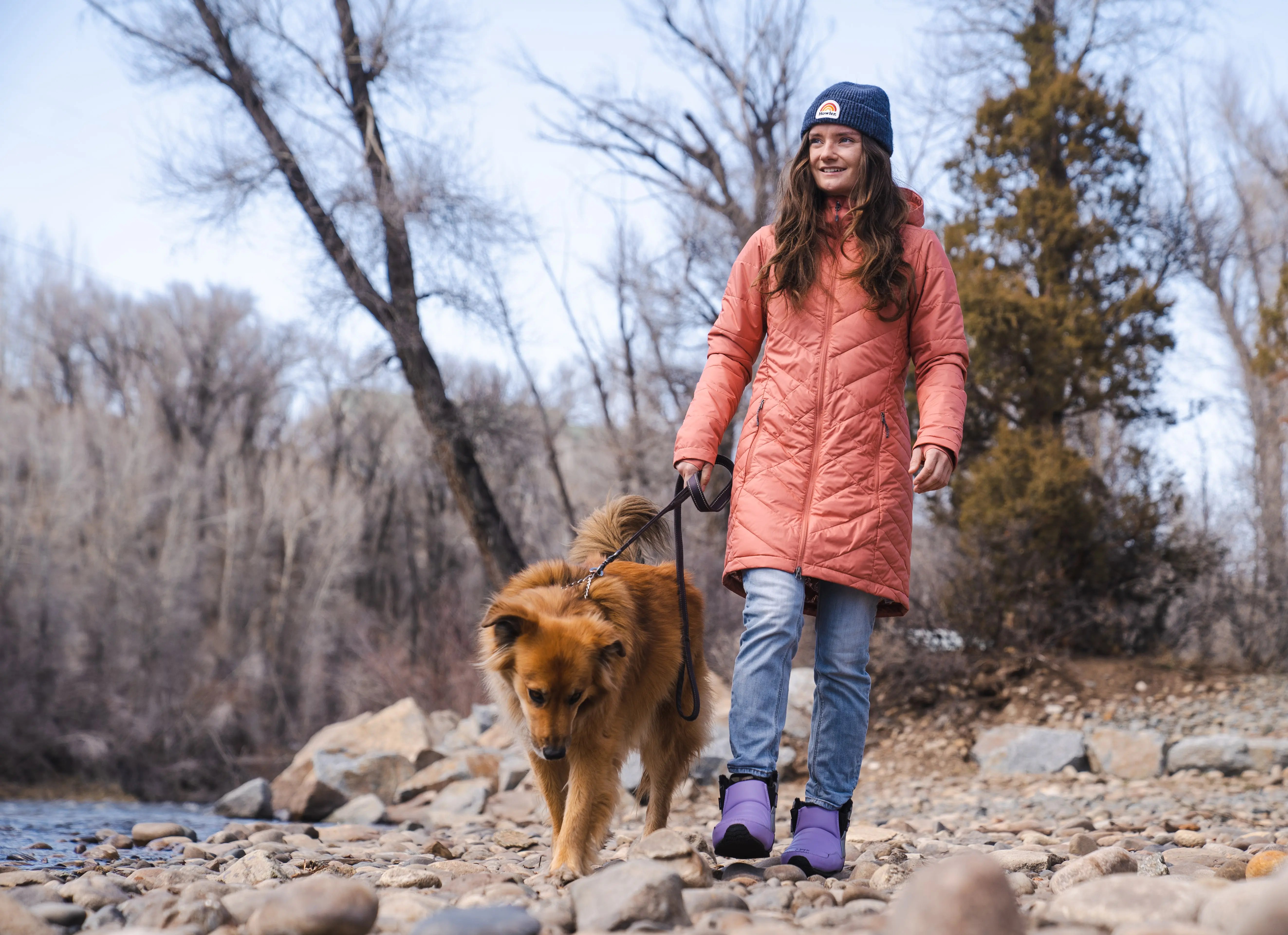



Cuff Closure
Along with cuff lengths, down booties use various mechanisms to provide your feet and ankles with protection from debris, cold breezes, snow, and other intrusive elements. These cuff closures tend to be elastic bands or adjustable drawstrings.
Drawstring Closures
Several of the down booties listed in this guide utilize a drawstring and toggle closure. Essentially, an elastic cord is threaded through the cuff and can be tightened or loosened by adjusting the toggle lock. Drawstring closures are adjustable, allowing the user to customize their fit according to preference. This drawstring closure is most commonly found in mid-calf styles like the Baffin CUSH Booties. But the above-the-ankle Big Agnes Full Moon Camp Booties utilize this engineering as well.
Elastic Closures
Some down booties are designed with an elastic cuff closure that fits snugly around the ankle or lower leg. The elasticity stretches and conforms to the wearer’s leg. Thus, it provides a secure closure without any added bulk from toggles or strings. Elastic cuffs are simple and can be comfortable if the fit is just right. However, if they are too loose or tight, you are limited in adjustability. Our choice for a down bootie with an elastic closure? The Montane Icarus Hut Boot Style Slippers.
If you can’t decide between an elastic or drawstring closure, consider how you’ll use your down booties. And, ask how much added security you prefer. If you are looking for something to wear casually or just around camp, an elastic band closure will work. But if you’re going to be using your down booties while trudging through snow, a drawstring closure will be best.
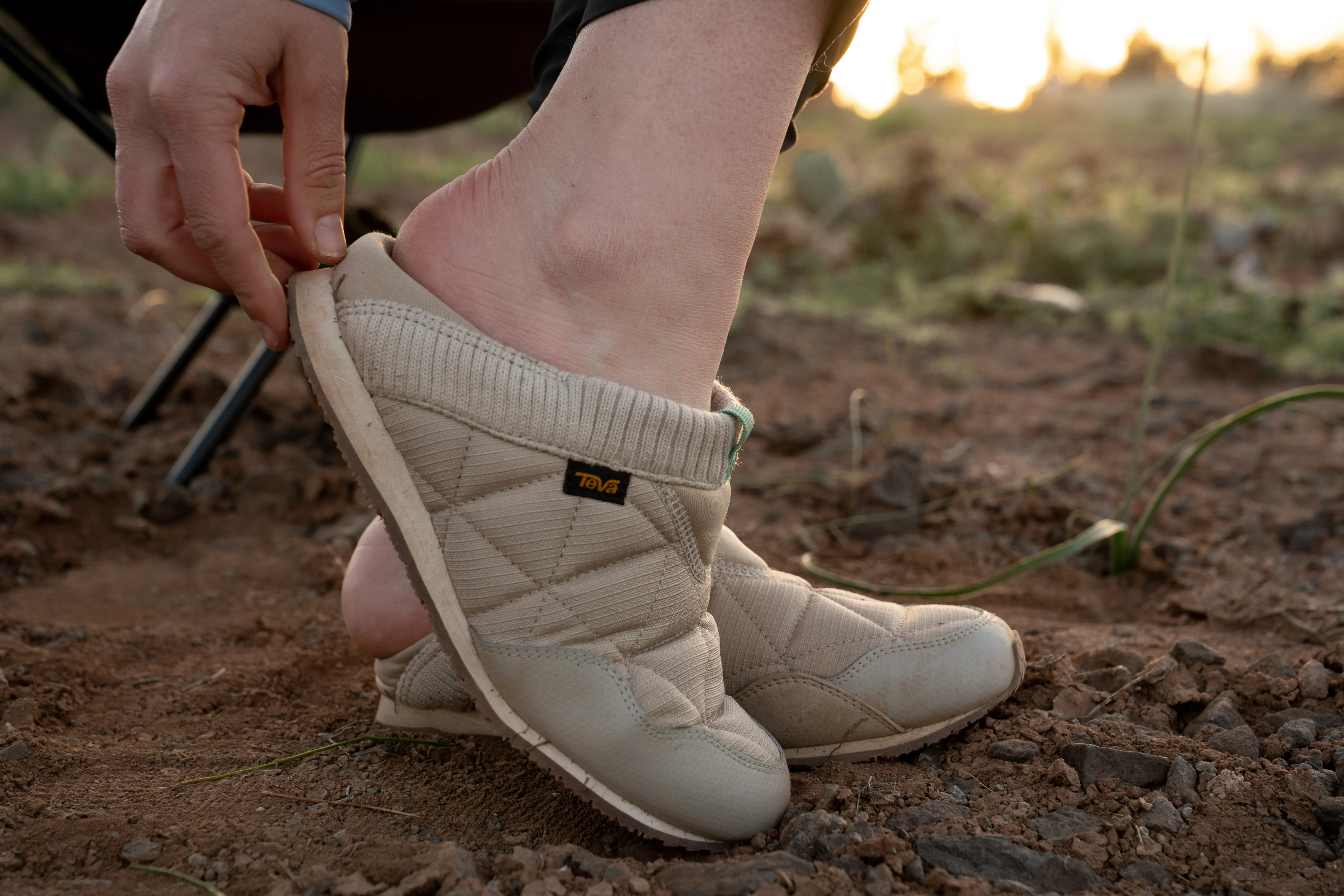



Convertible Heel
Because so many down booties are designed to be thrown on in a jiff — especially after ripping off a pair of ski boots or switching out of some hiking shoes — some designs come in convertible fashions that offer a 2-in-1 style. These pairs can switch from a shoe to a slipper by folding the soft heel piece down. This functionality is perfect for folks needing some versatility or needing to quickly enter and exit their shoes.
We’ve tried a few slipper-down bootie hybrids, and we were fans of the Teva ReEMBER for its easy conversion. The Danner Jag Lofts also offer the same feature, making them adaptable.
Packability
If you are planning on taking your down booties on excursions, road trips, or in your suitcase across the world, you will definitely want to consider the shoe’s packability. A down bootie’s ability to compress in a backpack or duffel depends mostly on its materials and insulation type.
Down booties made with a natural down instead of synthetic tend to be more compressible than the latter. However, synthetic insulation can be just as lightweight and packable if done correctly. Consider grabbing a stuff sack for your down booties so you can optimize the space in your luggage for other gear and clothing. This will also help protect your other items from any dirt or moisture that may be on the soles of your booties from all the adventuring.
When traveling with down booties, make sure to think about how its sole and traction affect the shoe’s ability to fit inconspicuously in your bag. Down booties with a thicker sole and added traction will be harder to compress than those without.
If you are looking for down booties that are packable and ready for any adventure, several of these pairs are efficiently compressible and lightweight, including the Rab Down Hut Slipper.
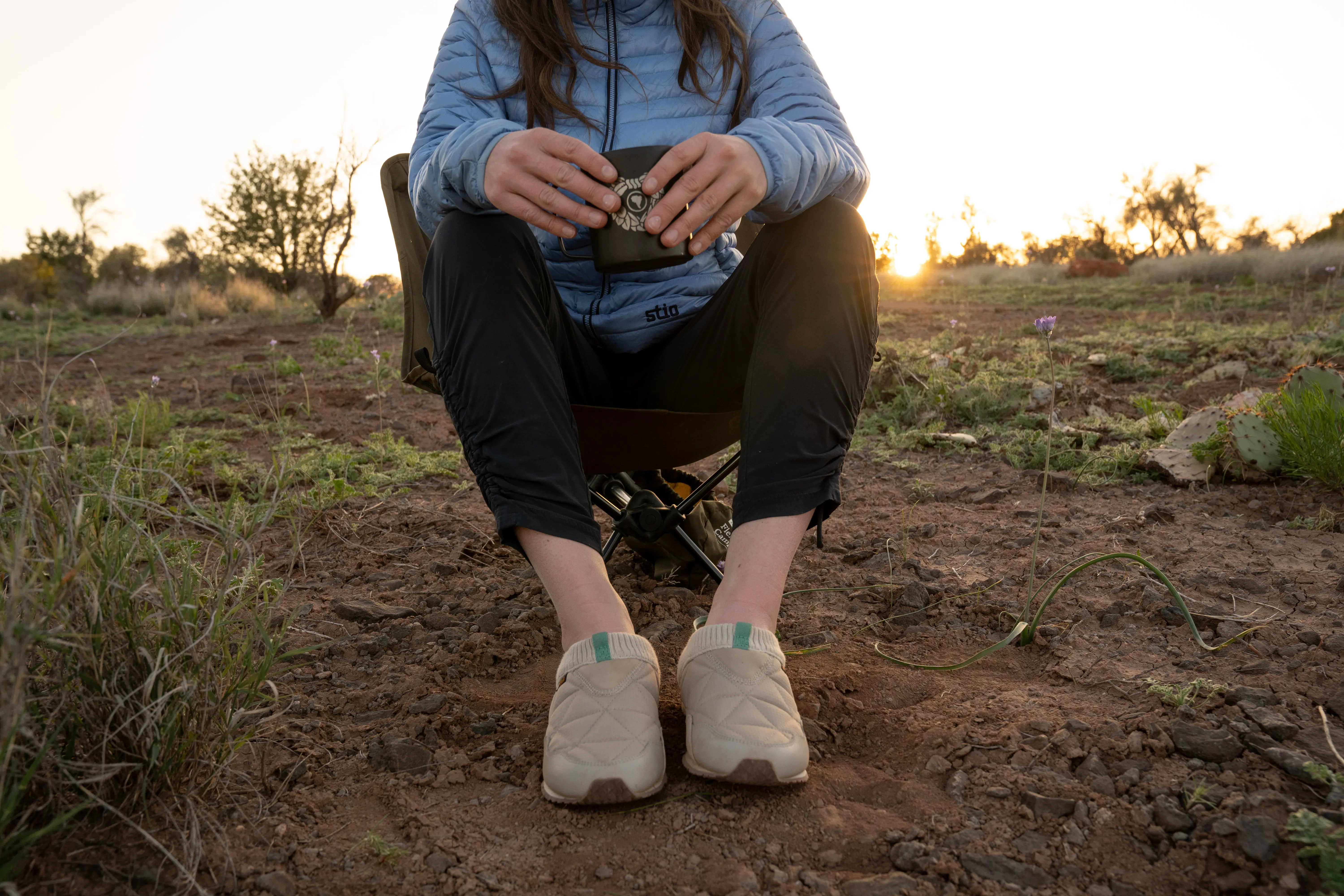



Weight
Along with packability, weight should be taken into consideration before purchasing a pair of down booties. Most down booties are naturally agile, as they are constructed with materials that tend to be almost weightless. Our options in this guide range from as little as 57 grams up to 539 grams.
Ultimately, the deciding factor of a down bootie’s weight is its materials. Down insulation, both synthetic and natural, tends to be pretty lightweight when it’s dry. In terms of exterior fabrics, the nylon and polyester materials these down booties are constructed from are also conveniently lightweight.
What we found added weight to these various down booties was the use of tractioned soles. For example, the North Face Thermoball Traction Booties have a thick rubber sole with added tread, causing them to weigh in at 17 ounces. They still aren’t any heavier than a regular pair of boots, but would still be pretty noticeable in your backpack on the skin track to the hut. However, with this added weight comes an added element of durability and mileage.
The down booties without added or thick soles are the lightest on our list. If you are looking for the lightest down booty option that will be hardly noticeable in your pack, the GooseFeet Gear Down Socks are the way to go.
Most of the down booties on this list are around the same weight and should feel light in your pack, so don’t let this aspect concern you too much in your buying process.
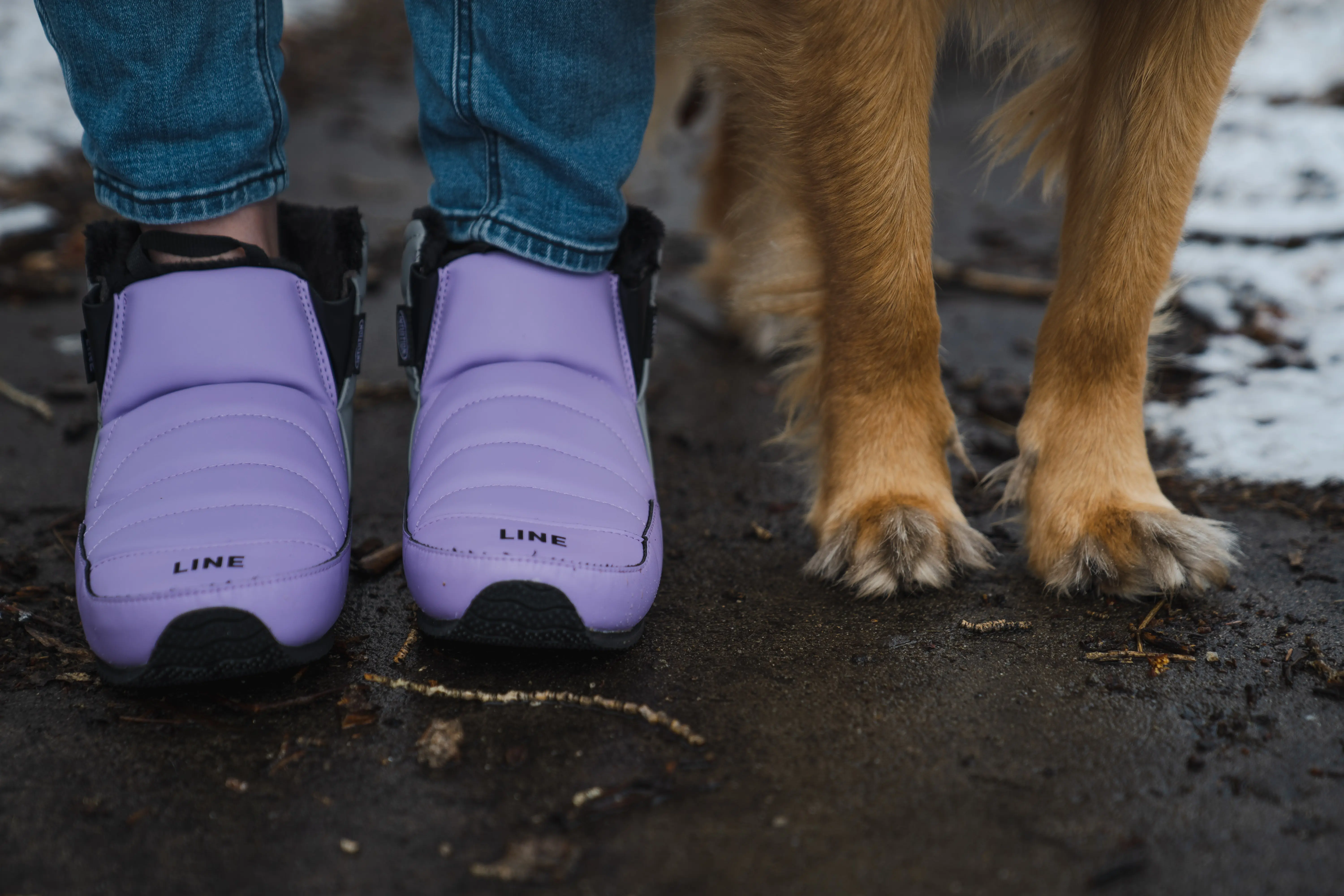



Here are the weights of all of our choice down booties broken down into lighter, moderate, and heavier weight categories:
Lightweight (Less than 7 oz.)
- GooseFeet Gear Down Socks (2 oz. or 58 g)
- The North Face Summit Advanced Mountain Kit Sleeping Sock (2.75 oz. or 78 g)
- Rab Hot Socks (3.8 oz or 109 g)
- Western Mountaineering Flash Down Booties (3 oz. or 85 g)
- Outdoor Research Tundra Aerogel Sock (5.5 oz or 156 g)
- Western Mountaineering Standard Down Booties (6 oz. or 170 g)
Mid-weight (7-12 oz.)
- Baffin CUSH Booty (11 oz. or 312 g)
- Teva ReEMBER (7.5 oz or 213 g)
- Rab Down Hut Slipper (7 oz. or 198 g)
- Montane Icarus Hut Boot Style Slippers (7.1 oz or 201 g)
- Big Agnes Full Moon Camp Synthetic Booties (6 oz. or 170 g)
- Sierra Designs Down Booties (9.5 oz. or 269 g)
- Oboz All Gender Whakatā Puffy Mid (10.9 oz or 309 g)
Heavyweight (Over 12 oz.)
Heavyweight (Over 12 oz.)
- The North Face Thermoball Traction Booties (17 oz. or 482 g)
- Danner Jag Loft (19 oz. or 539 g)
- L.L.Bean Women’s Mountain Classic Quilted Booties (16 oz. or 454 g)
Overall, when choosing a down bootie relative to its weight, consider the tread, materials, and packability. Down socks without added tread will always be significantly lighter, whereas down booties with larger soles and greater durability will be heavier.
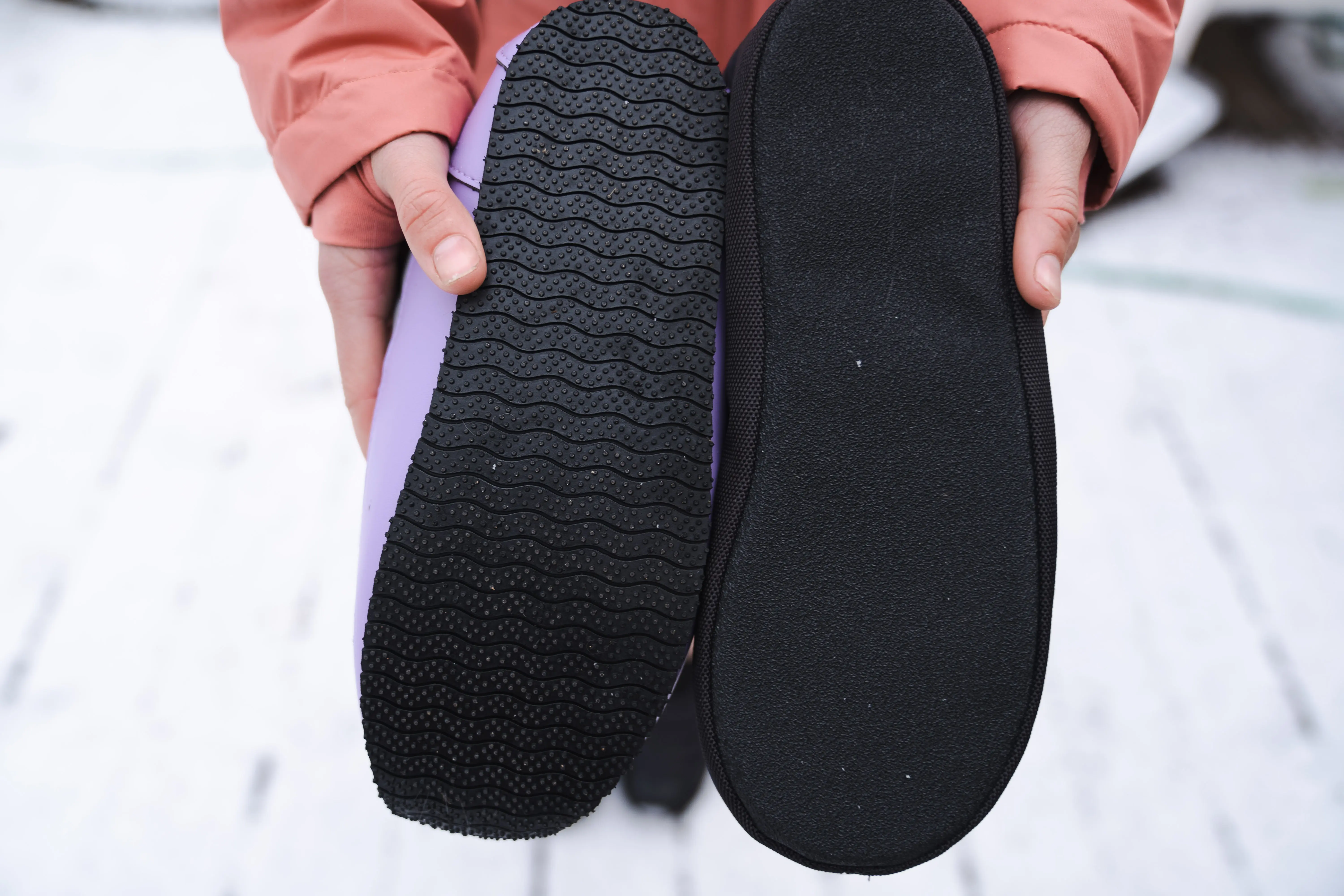



Sustainability
If you care about the planet and where your products come from, then it is important to know how sustainably sourced your down booties are.
When thinking about sustainability in down booties, it is important to consider their down sourcing, manufacturing processes, and use of environmentally friendly materials.
Many down booties in this guide incorporate recycled materials in their construction. This can include using recycled fabrics for the outer shell or utilizing recycled down insulation. Choosing booties made from recycled materials helps reduce waste and minimize the environmental impact of the manufacturing process. Additionally, you can opt for booties that use eco-friendly dyes and coatings in their production to prevent any harm to the environment.
One choice for sustainably made down booties is the Montane Icarus Hut Boot Style Slippers, which are manufactured with 100% recycled materials. Montane has also recently rolled out a “know what you’re buying” initiative where you can get a detailed look into all of their products’ materials, recycled textiles, country of origin, and sustainability efforts. The Icarus Booties even scored a perfect score of 100.
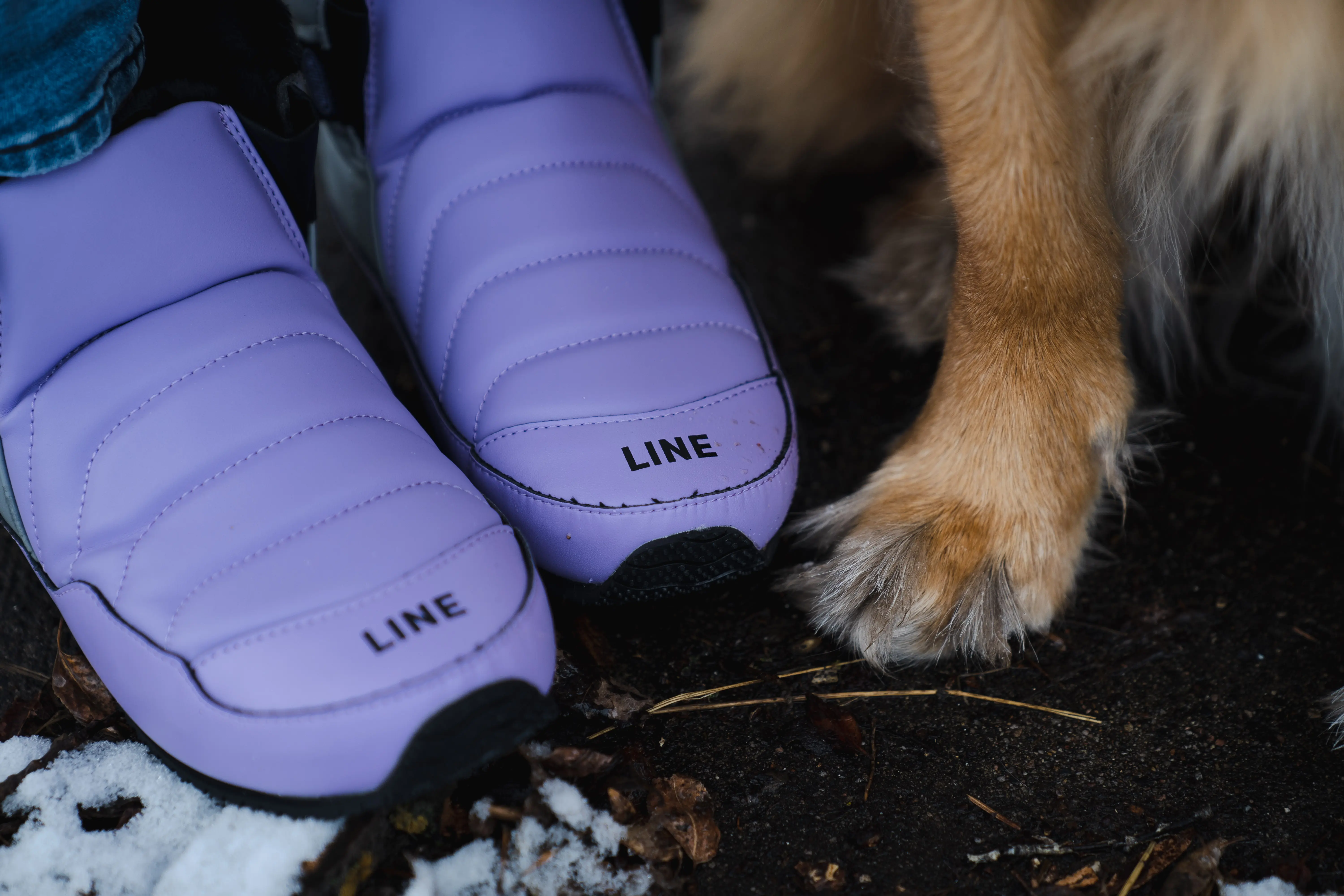



Responsibly Sourced Down & Traceability
While natural down made from bird feathers is a powerful insulation material, it is easy for abuse to occur in the supply chain. Many outdoor companies are making efforts to source down ethically and provide transparency to consumers.
If you are interested in learning where and how the down in your booties is sourced, you can! With the Allied Feather & Down’s TrackMyDown program, it is easy to see where the down in your booties came from.
Winner of a 2019 ISPO Gold Award, the TrackMyDown program provides detailed information on the source of your bootie’s down feathers, including the country of origin, the supplier, and the farms where the birds were raised. Customers can also view information on the quality of their down, including the fill power and the cleanliness of the material. Simply type in your lot number (found on your down bootie’s hang tag) and press enter.
Without providing such tools for transparency, abuse can become part of the supply chain.
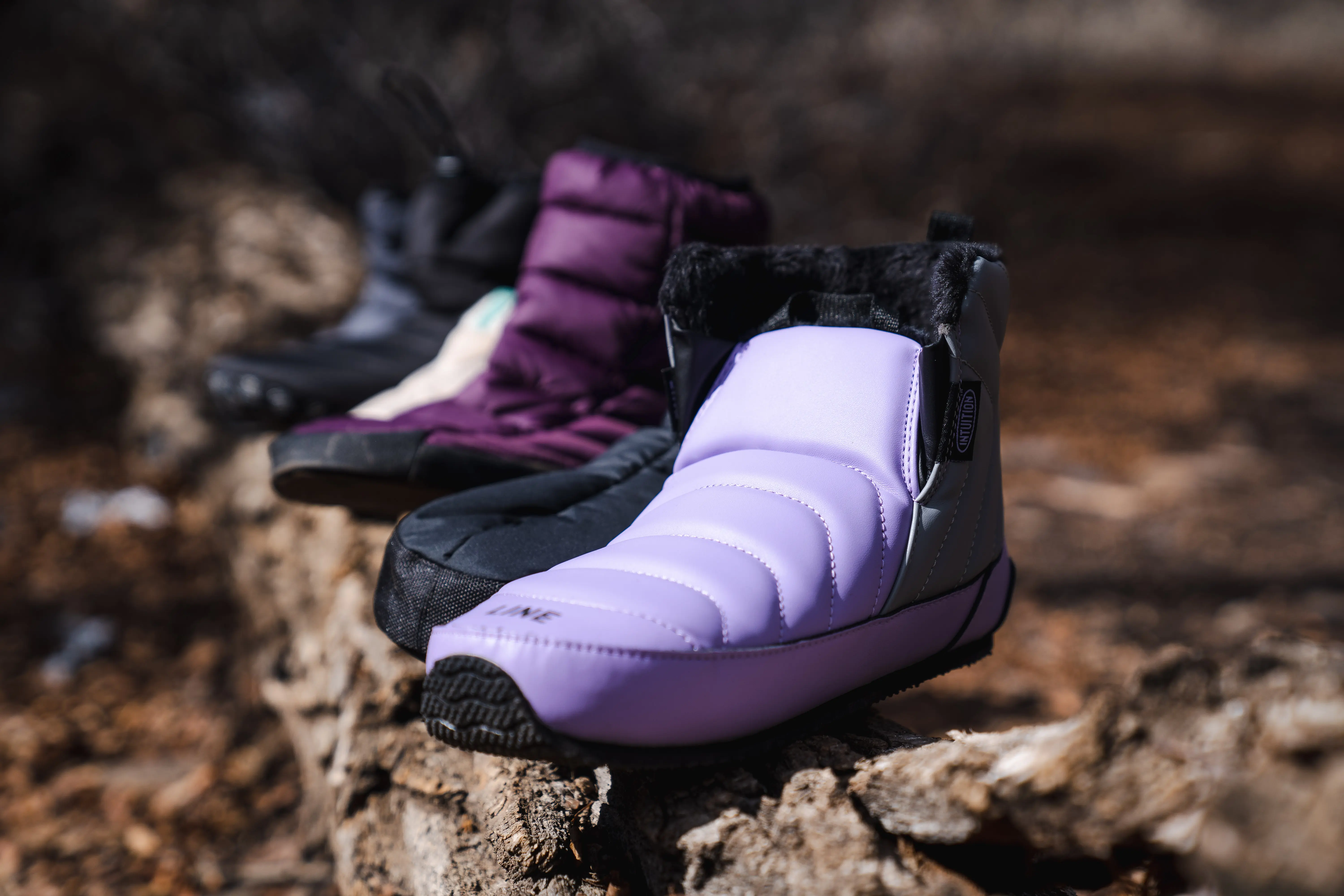



Finding Your Size
Unlike shoes, down bootie sizes tend to fall on a scale, usually between XS and XL. A letter size will then coordinate with certain U.S./U.K. men’s shoe sizes. Most booties are measured in unisex or men’s sizes, but some will also have women’s shoe sizes listed. The sizing and fit will also vary between brands, so we recommend always double-checking before making a purchase.
Price & Value
The price of down booties will vary, but the cost is mainly determined by the type of insulation, level of down fill, and materials used. You can expect to pay somewhere between $60 and $100 for a high-quality, warm pair of booties.
Budget
In this buyer’s guide, we have several different options for pricing. Our most budget-friendly options are the Rab Down Hut Slipper ($65) and the Baffin CUSH Booty ($60). These are very basic, packable, lightweight, and toasty slip-ons. These are made for indoor use and don’t offer foot protection against uneven terrain.
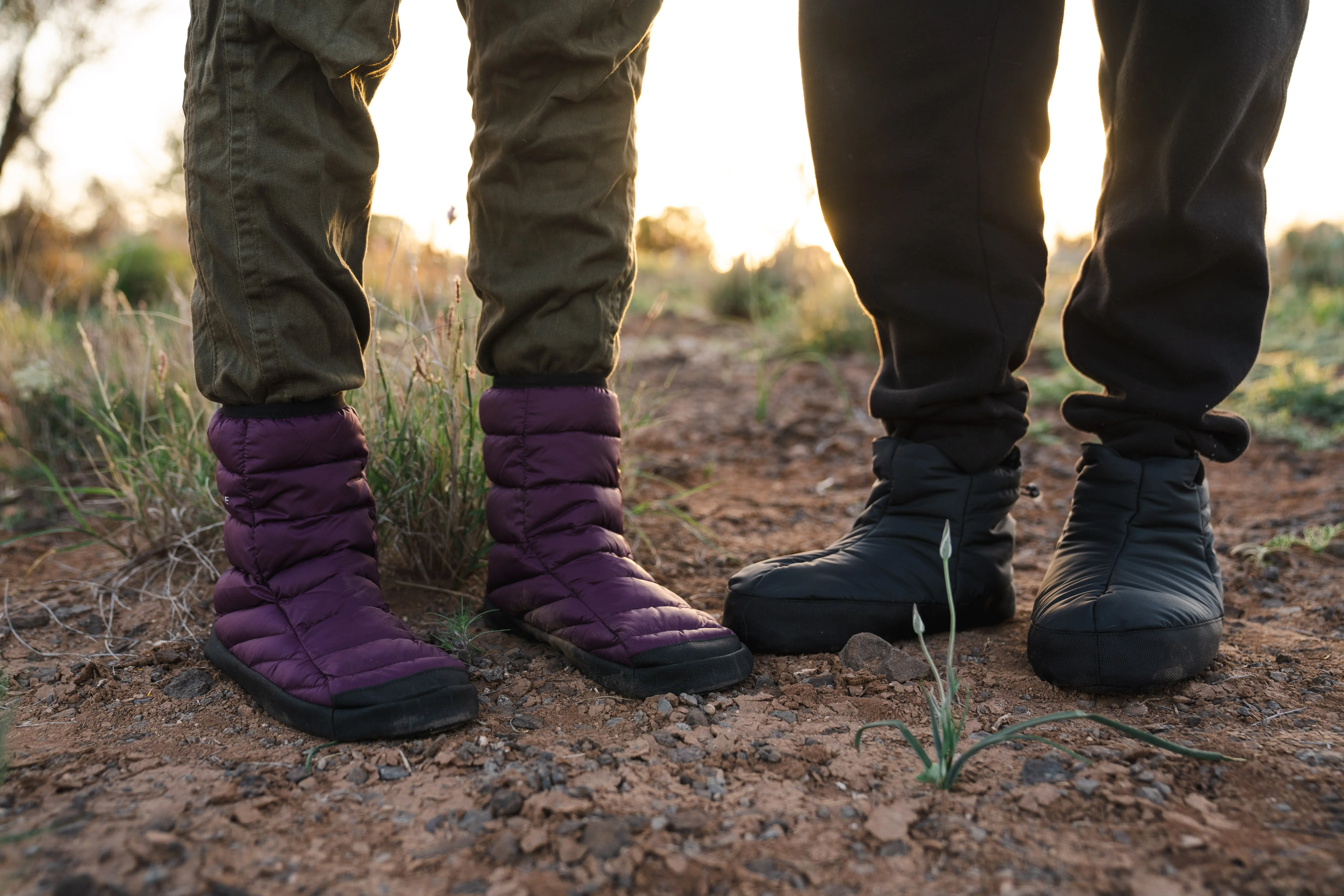



Mid-Tier
For our next price tier which includes down booties ranging from $70 to $90, we recommend Sierra Designs Down Booties ($80), Big Agnes Full Moon Camp Booties ($70), and Teva ReEMBER ($80), to name a few. These booties have supportive midsoles, outsoles, traction underfoot, and mindful ankle closure systems or additions like anti-odor treatment.
Premium
Our higher price tier includes options that are around $100, and we’ve seen some booties reach up to $400. Some premium down booties are highly customizable and have a sliding scale of price depending on how you design your pair. For example, GooseFeet Gear Down Socks start at $69 and can go up to $97. Of course, this all rides upon your preferences for down, fill, colors, materials, and other add-ons. You’ll also find the Rossignol Chalet Shoes ($99) and the Oboz All Gender Whakatā Puffy Mid ($110) in this price range.
Whether you are ready to spend a lot or a little on a pair of down booties, just know that all of the booties listed here are high quality and toasty warm.
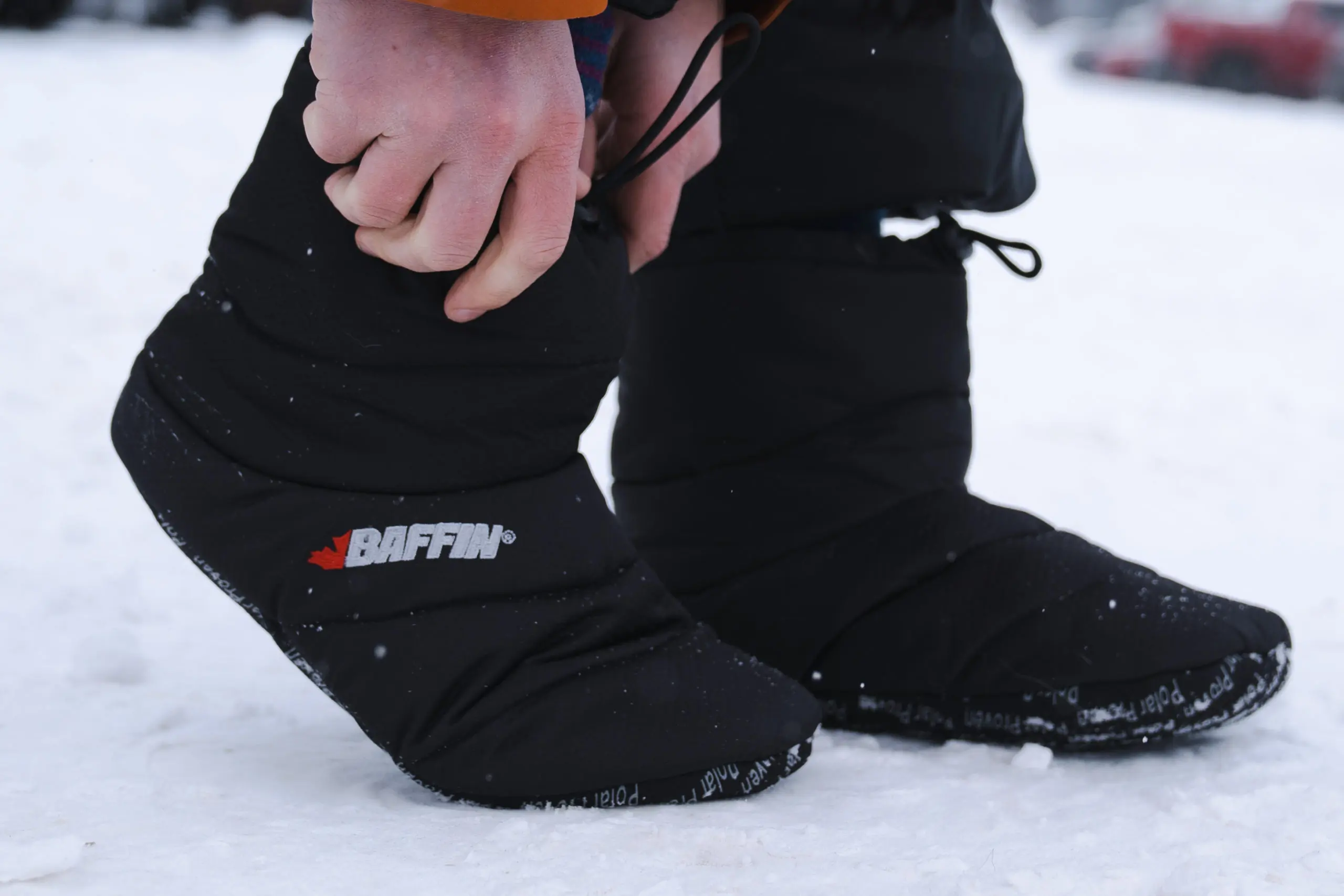



Frequently Asked Questions
Down booties are a type of footwear. To put it simply, their whole job is to provide insulating warmth during the winter months. Just like a down jacket would keep your core warm or puffy pants would keep your legs warm, booties keep your feet warm.
You’ll commonly see them worn in places like winter huts, inside four-season tents, or on trips for ski mountaineering, ice climbing, backcountry skiing and touring, winter camping, and more.
After a lot of wear, your down booties may need to be washed. You can do so by spot cleaning, soaking, or machine washing on a gentle setting. Make sure to use a down-friendly or delicate detergent to keep your booties in their best shape.
To dry, you’ll want to make sure you use a low-heat or no-heat setting and add wool balls to the dryer basin in order to help break up clumps of wet down. We also like to set them out in a sunny place for a few hours to ensure they are fully dry before packing them back up into a stuff sack or storage.
After they are dry, give them a few shakes to fluff them back to their original loftiness. Properly washing and caring for your down booties will help increase their longevity and keep your feet warm on all your upcoming adventures.
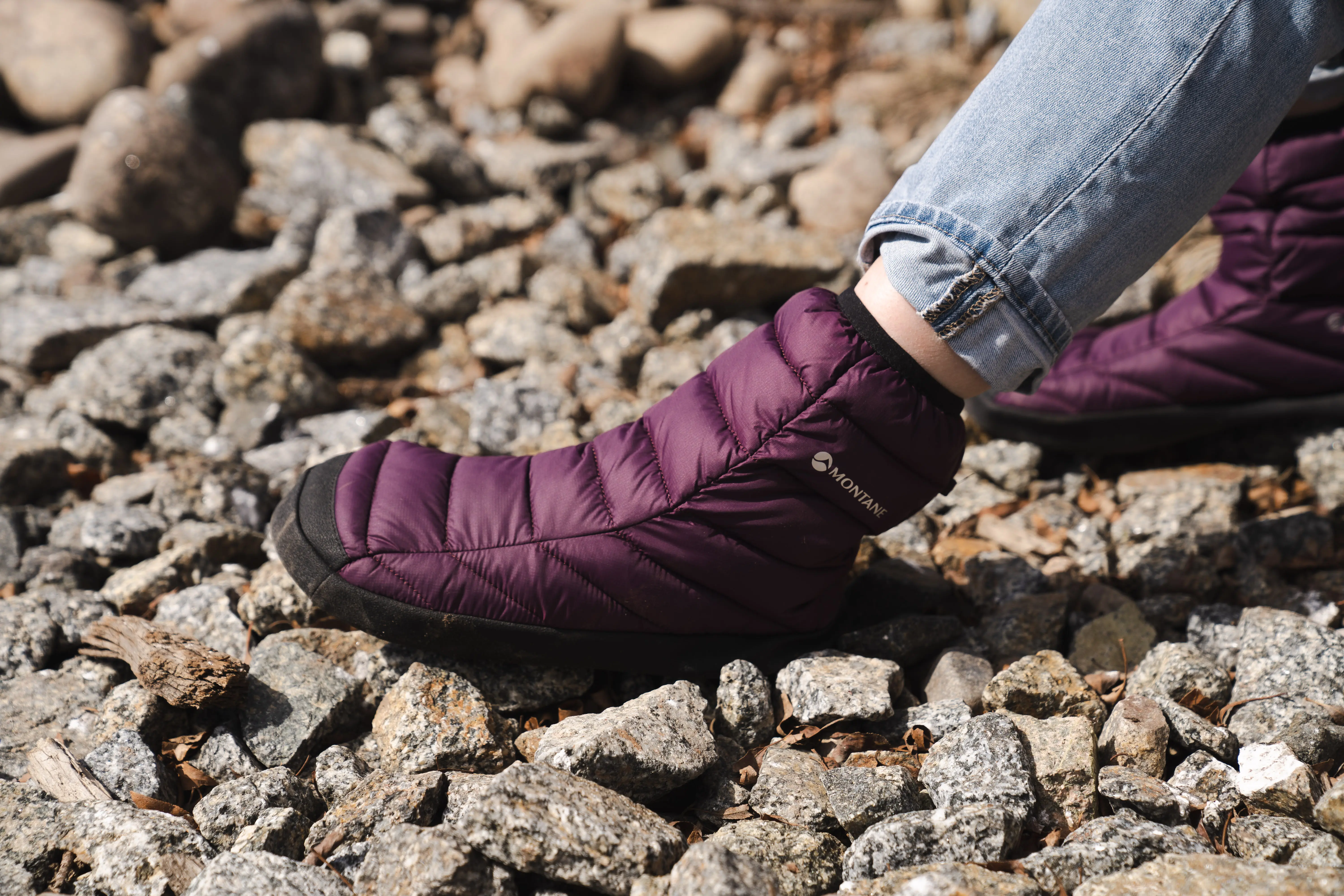



Many down booties are designed with a certain degree of water-resistance and soles made for use in harsher elements like snow, ice and puddles. However, some are made to be worn strictly inside or just lightly outdoors. Check to see if your down booties are made with hydrophobic fabrics or finishes before you make snow angels on those wet winter days.
Before you wear your down booties out in the snow, make sure they have tractioned soles that are thick enough to keep your feet insulated while you are walking. It is also important to pay attention to the cuff closures on your down booties. If they fit snugly around your legs and ankles to prevent any moisture or snow from entering your shoes, you should be good to go!
Wearing socks with your down booties is totally up to personal preference. Due to their insulation and moisture wicking properties, down booties typically don’t need to be paired with socks. However, if you think it would be more comfortable, we recommend wearing a thinner sock made of wool or breathable synthetic fabrics.
As always, avoid wearing cotton socks with your down booties. They will absorb any sweat or moisture without the ability to dry.
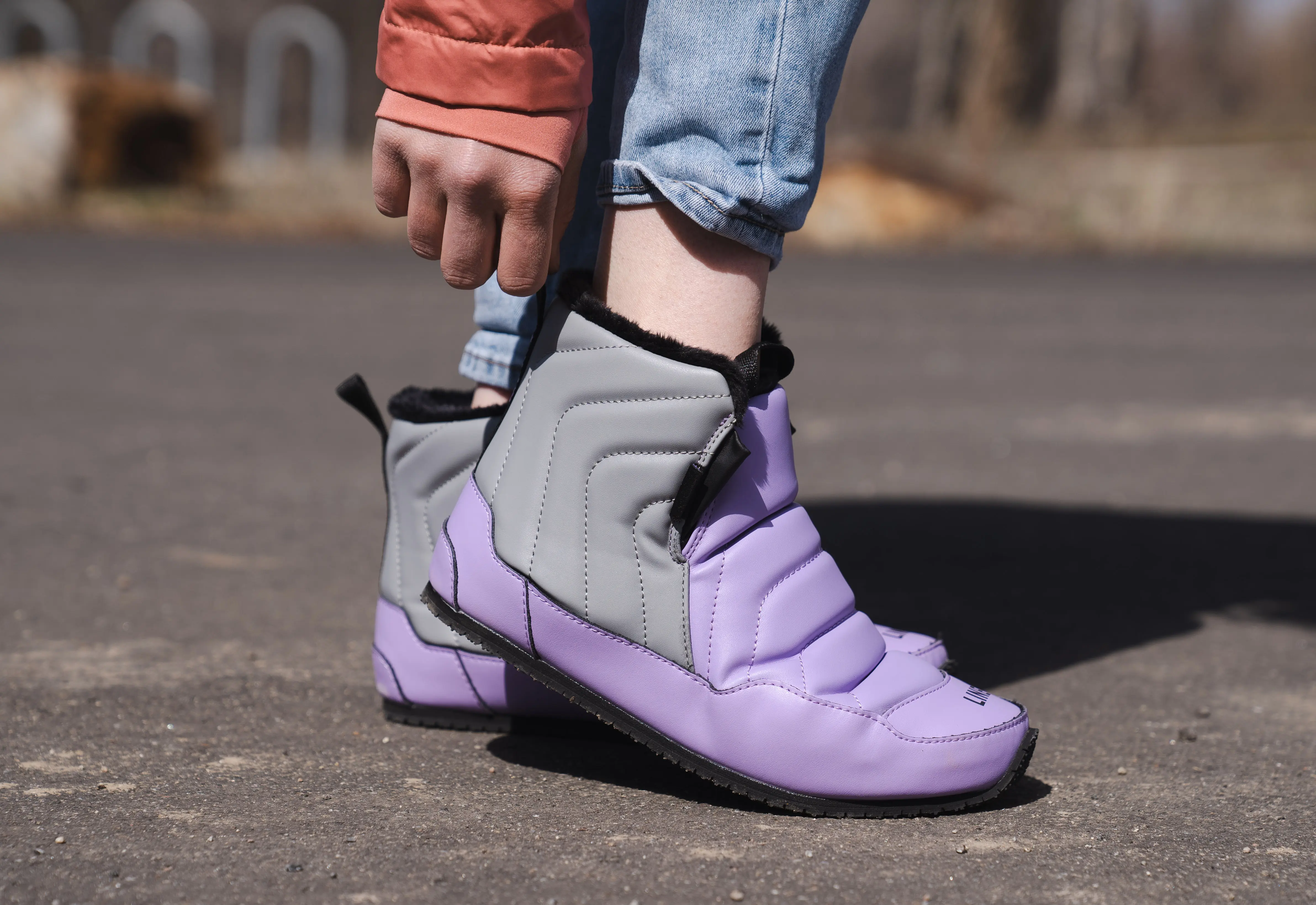



Yes! Many of the down booties listed in this guide were designed to be worn in a sleeping bag. If you tend to get chilly feet while camping, down booties are a comfy solution without taking up too much space or stopping you from getting a good night’s rest in your tent, car, or cabin.
Down booties that are easily paired with a sleeping bag are typically called down “socks.” They typically have no stiff sole or rubber tread so that your feet can move freely without feeling too cumbersome in your sleeping bag. Our pick for these down socks include the GooseFeet Gear Down Socks.
Because of their lightweight materials and typical construction of down insulation, down booties are highly packable. This makes them ideal for stashing in your backpack before you hit the trail, skin track, or hop on a plane. Since they are smaller in size, we recommend just sliding them into an open spot in your luggage. However, if you really want to optimize the space in your bag, try putting them in a stuff sack and then compressing out all of the air. This will keep your booties protected and make them easier to find when you’re ready to transition out of the ski boots.
Keep in mind that down booties with added soles or tread will be harder to pack. So, if you’re planning on strictly using your down booties in the hut or tent, we recommend purchasing a pair that does not have these weighted construction elements.
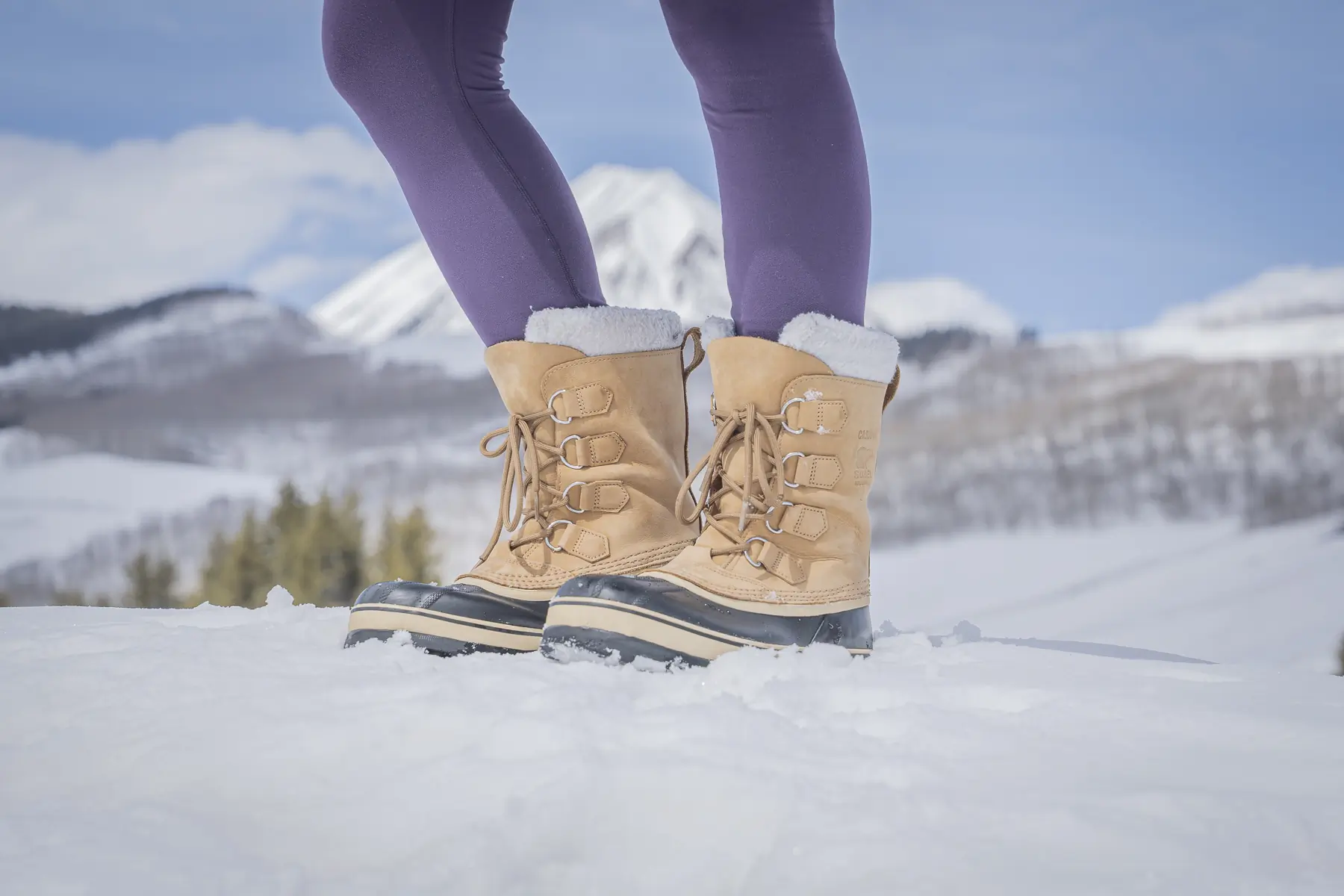

The Best Winter Boots for Women of 2025-2026
We tested the best winter boots for women in cold, snowy, icy, and sloppy conditions. Our top picks include Sorel, Timberland, and more.
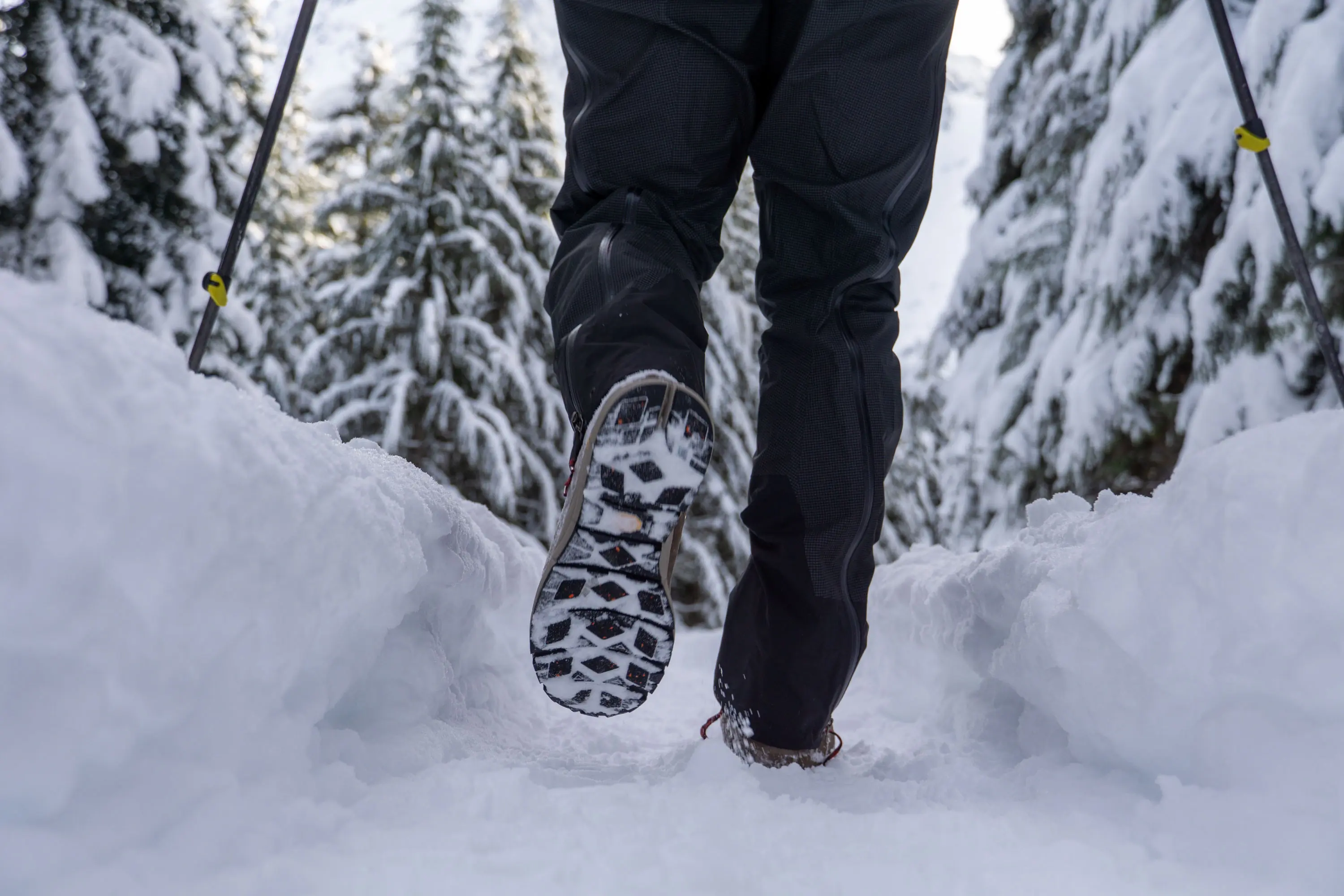

The Best Winter Boots for Men in 2025-2026
From hiking boots to snow boots, these are the best winter boots for men in 2024, including top picks from Danner, KEEN, Kamik, and more.

